Featured Comment:
“Thank you! This exactly explained what natto is & how to eat it. Now I need to find someplace near me that sells natto in pkgs.”
– Georgia
What is Japanese Natto?
Natto is a traditional Japanese food made from fermented soybeans. It’s characterized by its unique smell and stringy, sticky consistency, and is one of Japan’s most popular breakfast dishes. It is also one of the few processed foods where the whole soybean can be eaten as they are.
A bit like marmite (or vegemite for Australian readers), natto is well known for being one of those foods you either love or hate, there’s no in-between!
It is also famous for its unique fibrinolytic enzyme called “nattokinase” which supposedly has many health benefits. I won’t dive into the details, but if you’re interested in learning more, you can check WebMD.
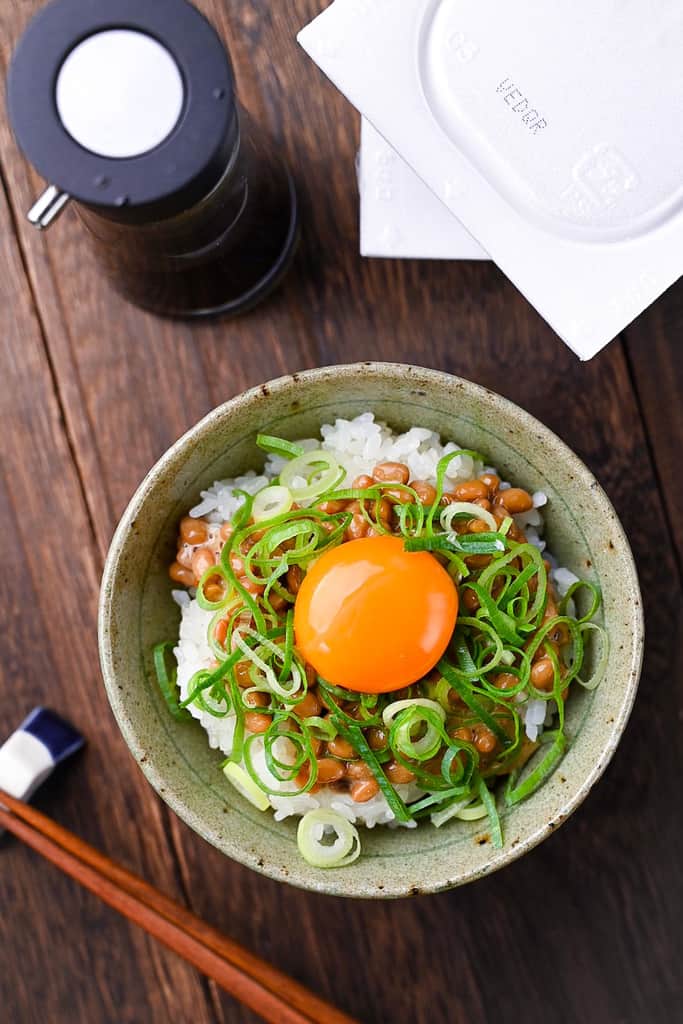

How I Developed This Recipe
I’ve been a fan of natto for as long as I can remember, and my passion for this unique Japanese food has only grown over the years. Natto has been a staple in my diet for as long as I can remember, and I still enjoy it almost daily.
Given my long-standing relationship with natto, I’ve picked up a lot of knowledge, done a lot of experiments, and gained a lot of experience that I’m excited to share with you in this article.
If you’re just curious about natto, thinking about trying it for the first time, or you’re already a natto fan, this article is perfect for you.
3 General Types of Natto
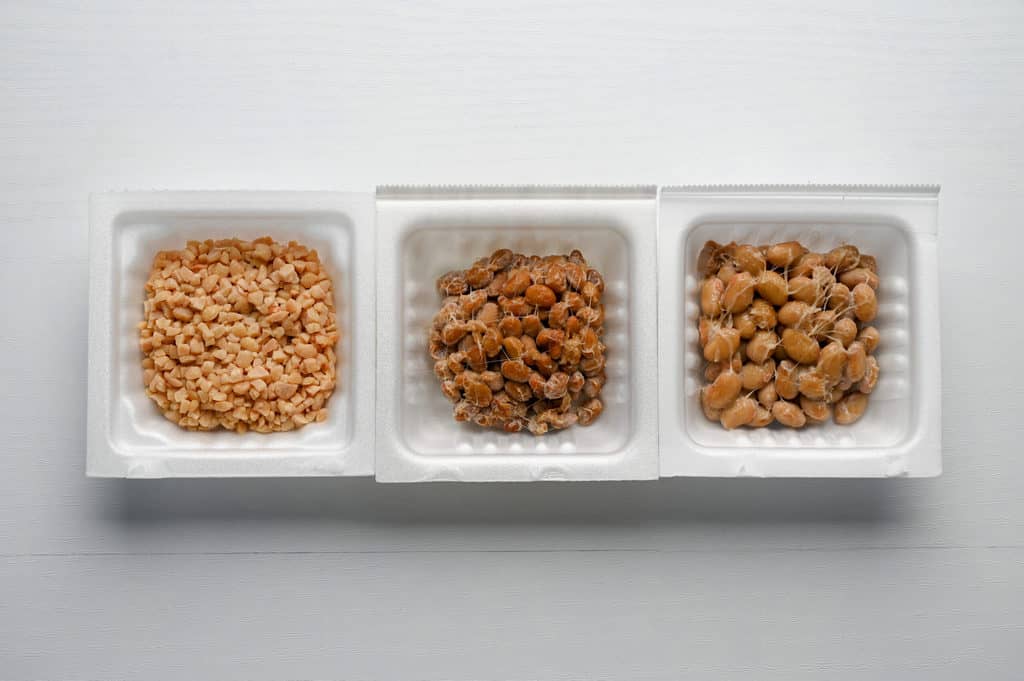
In my opinion, you can categorize natto into 3 categories:
- Normal sized natto
- Hikiwari natto (ground up)
- Ootsubu natto (use giant soybeans)
Normal sized natto
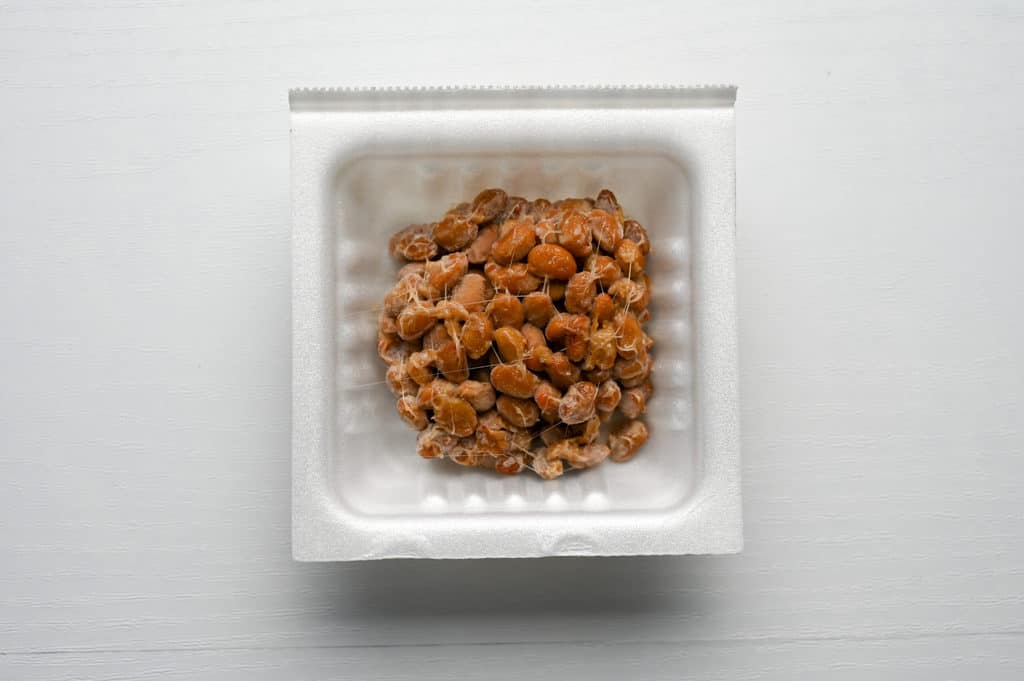
I would say more than 50% of natto products are in this category. At least this is something we consider “normal size.” If you would like to try natto for the first time, I recommend this one.
Hikiwari natto
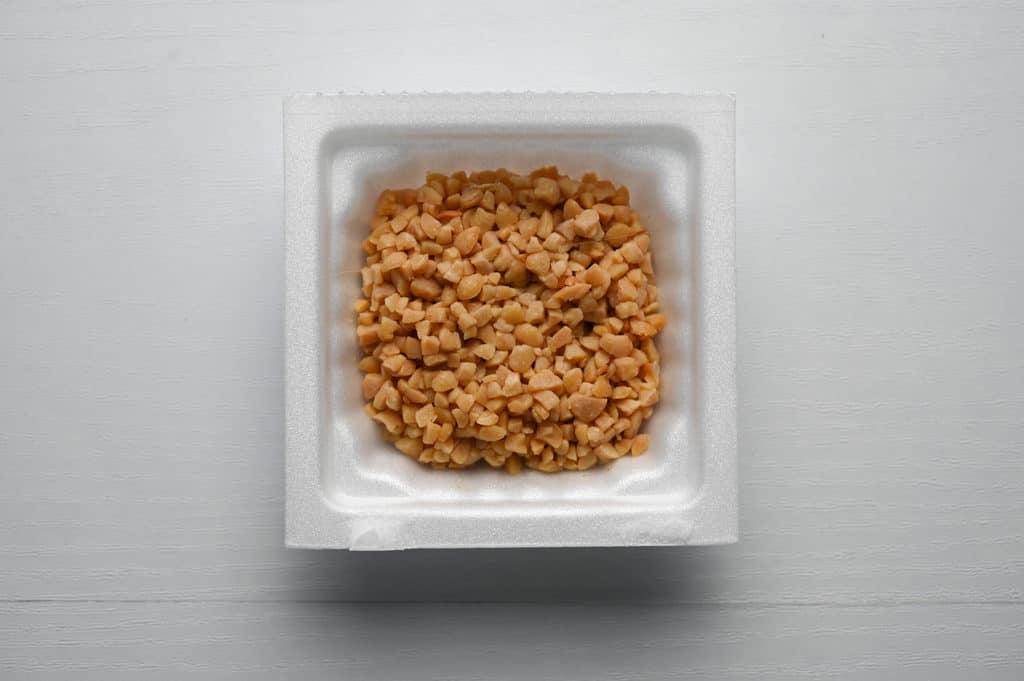
Hikiwari natto is a type of natto made from large, fully ripe soybeans that have been ground and cracked using a mill-like device. Hikiwari natto only covers about 7-8% of the natto market, but in some parts of the Tohoku region, this particular natto is preferred to any of the others.
Because the bits are tiny, it can be a little difficult to pick up with chopsticks and tends to stick to things, however, in my opinion, the taste is a little milder than regular natto, so it’s quite easy to eat taste-wise.
Ootsubu natto
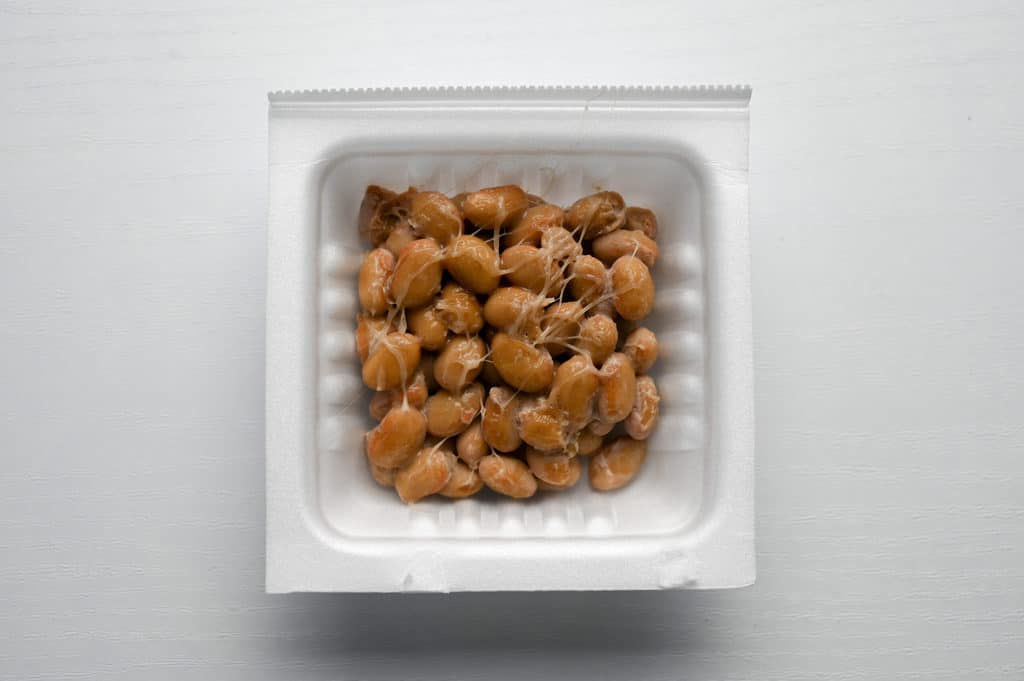
This type of natto is made with giant whole soybeans, so you can enjoy each soybean to the fullest.
However, this is more for natto lovers; the taste and texture are more pungent than the others. I do like this ootsubu natto, but it’s not usually my first choice.
It’s also very filling.
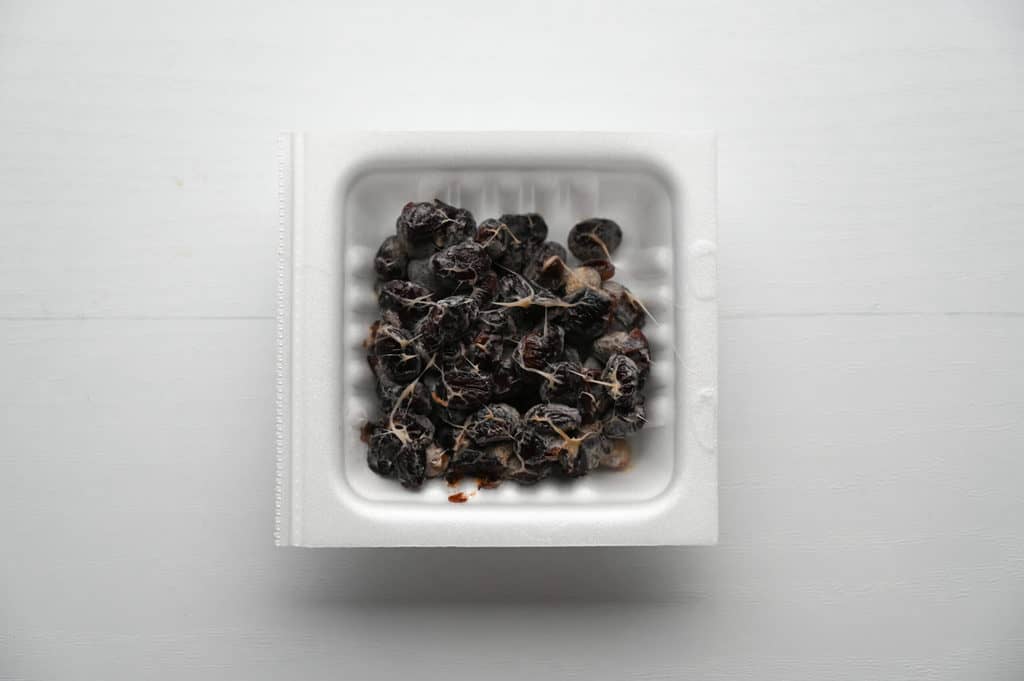
How to Eat Natto Like A Pro
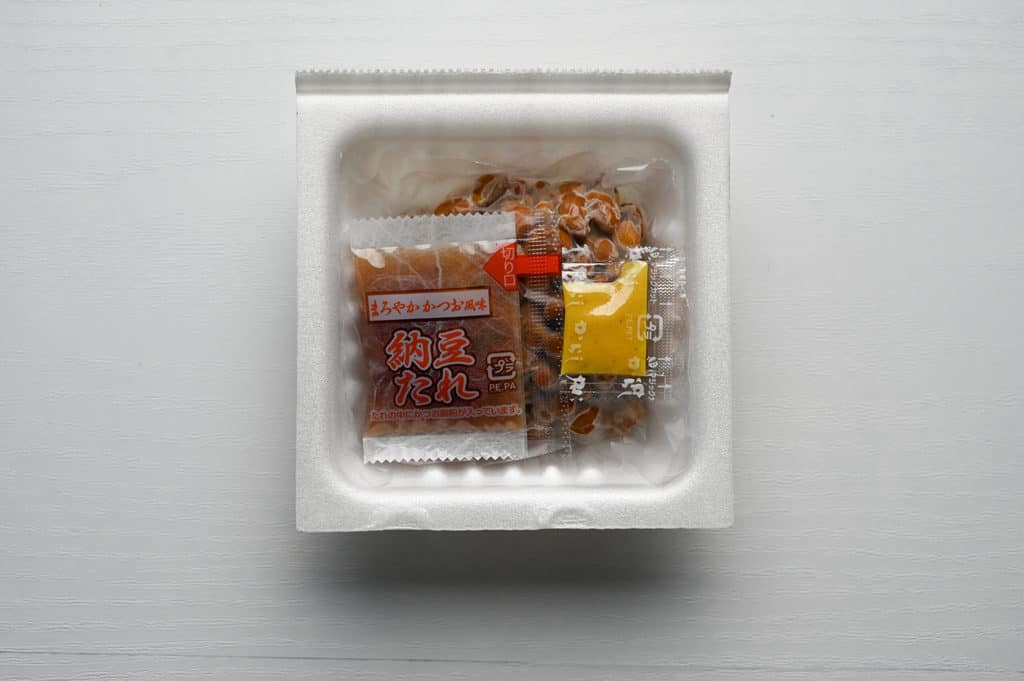
Okay, enjoying natto is not as straightforward as just picking it up and eating it. There are a few steps you need to follow before you eat. So here, I will list the typical steps you should follow before you start eating natto!
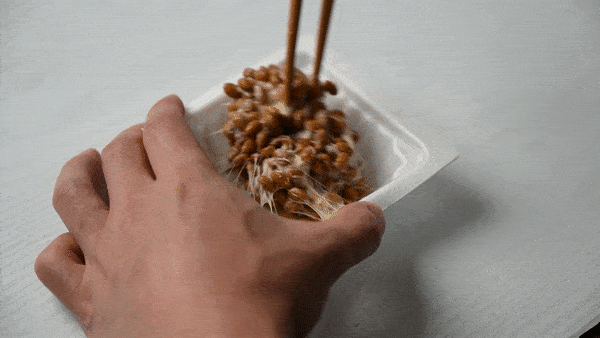
I know a pack of natto comes with sauce and Japanese mustard, but we’re going to mix natto as it is without any of these sauces.
Make sure to mix 50 times, ideally 150 times! And mix fast!
This basically whisks air into the film that coats the beans, making it fluffy and light. It also helps release umami, so the more you mix, the better the taste and mouth feel!
This is an extremely important step to take to make natto more enjoyable.
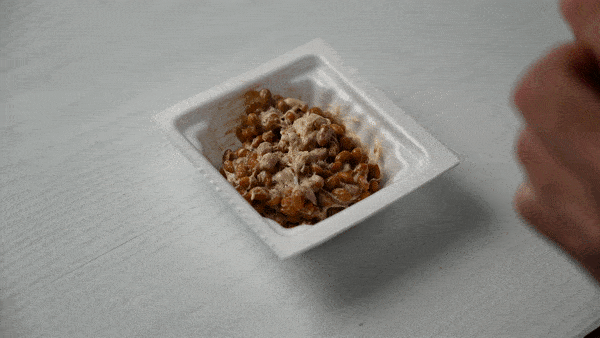
After mixing natto enough on its own, add the sauces and toppings (e.g., chopped spring onion).
Mix again until they’re incorporated.
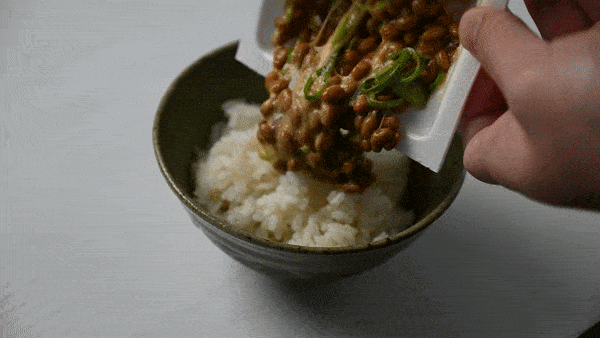
I personally eat natto as it is, but more than 90% of people put natto on a bowl of hot rice and eat it that way. It’s not so strong on rice, so I recommend doing it this way if you’re not used to it yet.
5 Best Natto Brands in Japan
This might not be relevant to people who live outside Japan, but I thought people who live in Japan from abroad might want to know which one to try first.
So, I will list the 5 best natto brands in Japan here!
It took me a long time to make this list (and the whole article…) as I actually bought each natto pack one by one and ate all by myself.
Okame Natto: Tsuyu Tappuri
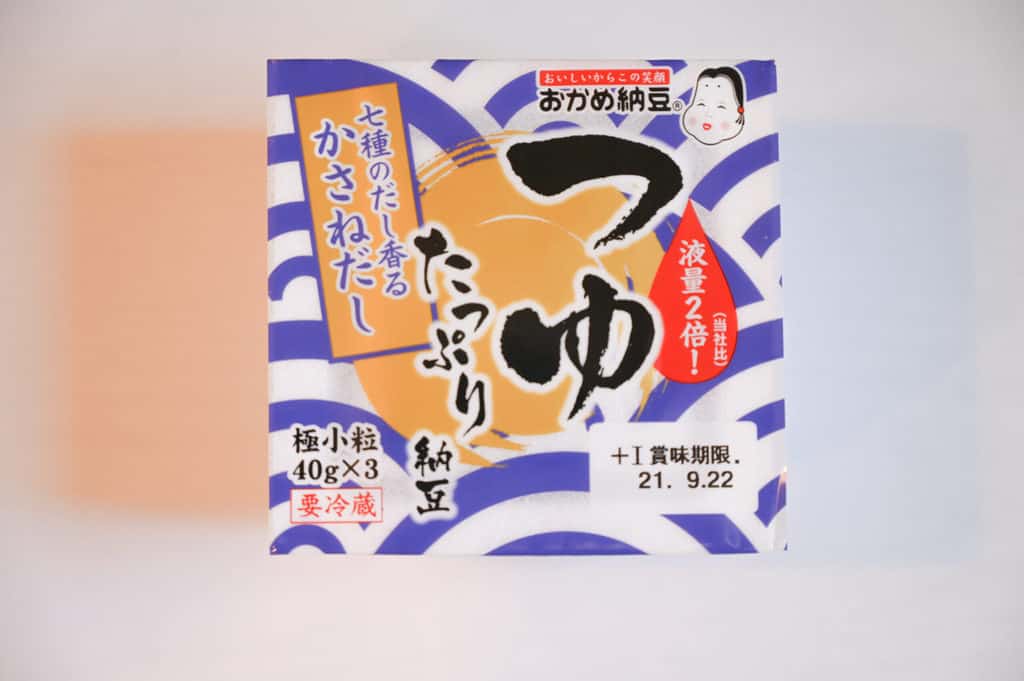
I’ve been a fan of Natto basically my whole life, and this is my go-to brand. Tsuyu tappuri (つゆたっぷり) means there’s extra sauce, making it extra tasty and full of umami!
The beans are relatively small but not hikiwari, which is my favorite kind too.
Mizkan: Hone Genki
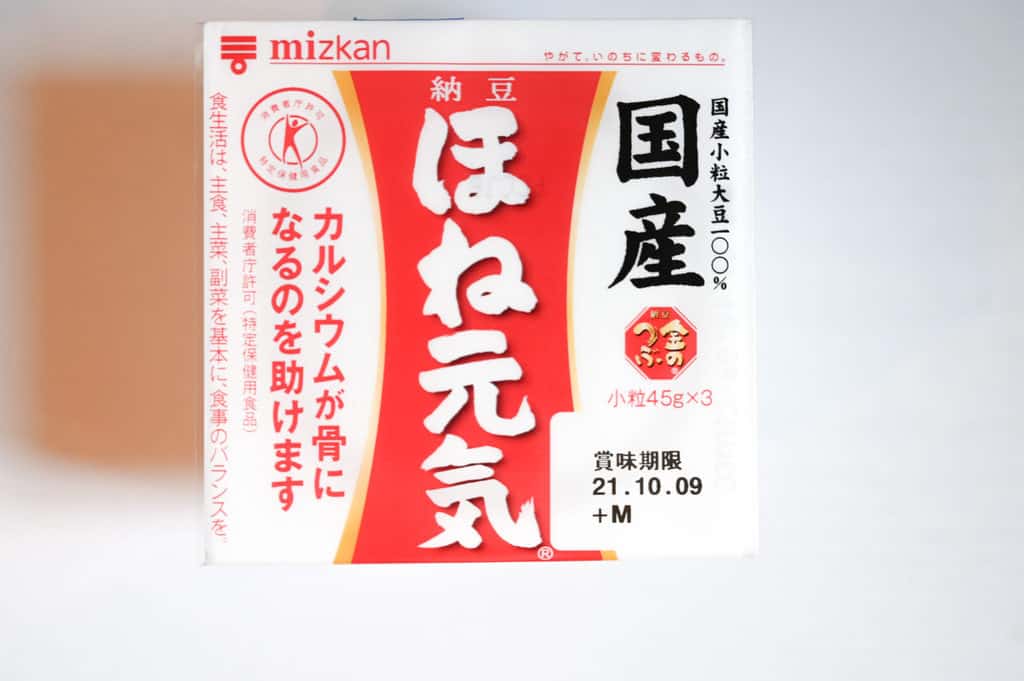
Absolute classic! This brand has been around since I was a little kid, possibly even before I was born. The soybeans are also relatively small too.
If you wanna try “the most standard natto,” this is the one to go for.
Mizkan: Kin no Tsubu Niowa Natto
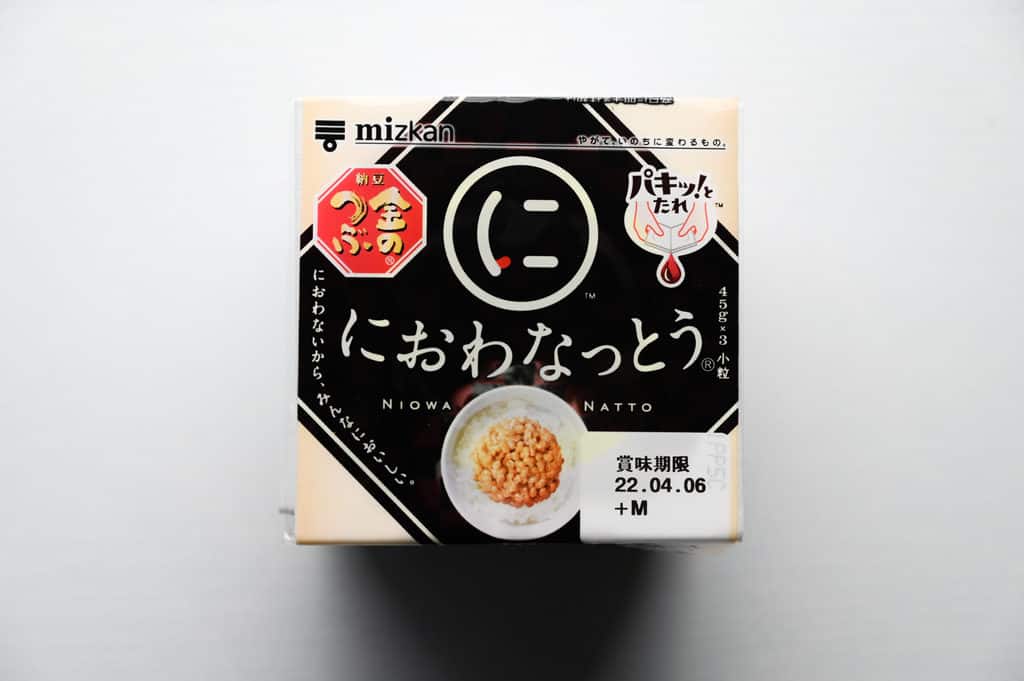
Another classic! “niowa natto” implies special natto without a strong smell.
I know one of the main reasons some people dislike natto is the smell, but does this really not have a smell? No, it doesn’t. Funnily enough, my English wife cannot stand natto (just yet), but she says she can’t smell this one.
This is definitely a good option for very first-timers!
Okame Natto: Yama Wasabi Natto
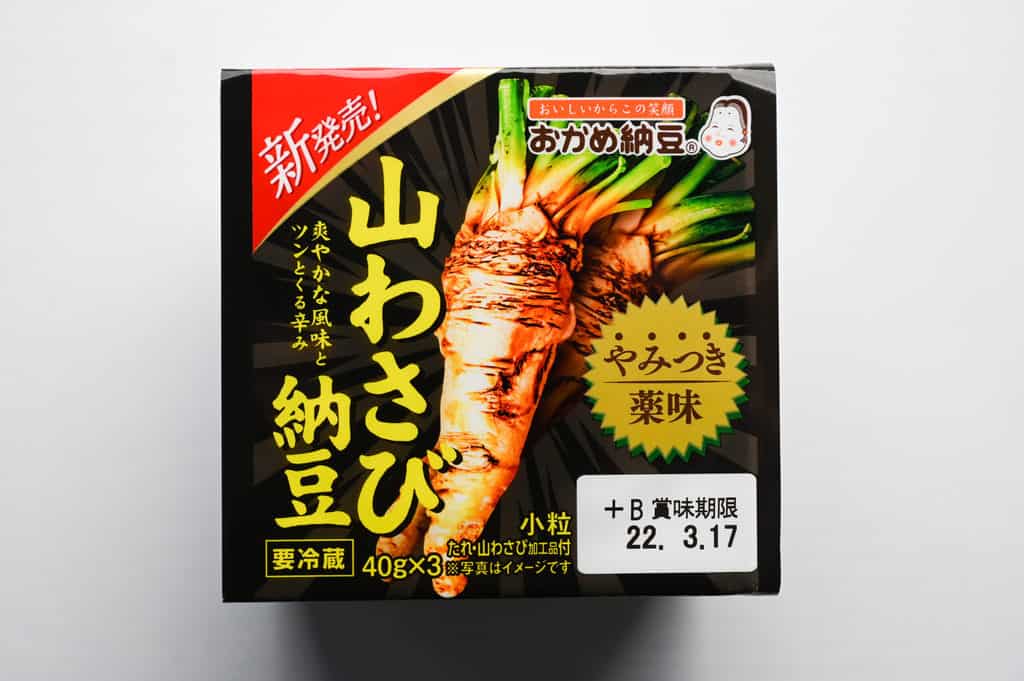
You will probably be surprised how many kinds of natto there are in one general supermarket in Japan. There are not only these general nattos I have explained above, but also kinds of natto with twists.
As the name suggests, this one has yama wasabi (horse radish, not wasabi) instead of mustard.
I must say, this one is definitely by far the best natto pack with a twist so far.
Mizkan: Tamago Shoyu Tare
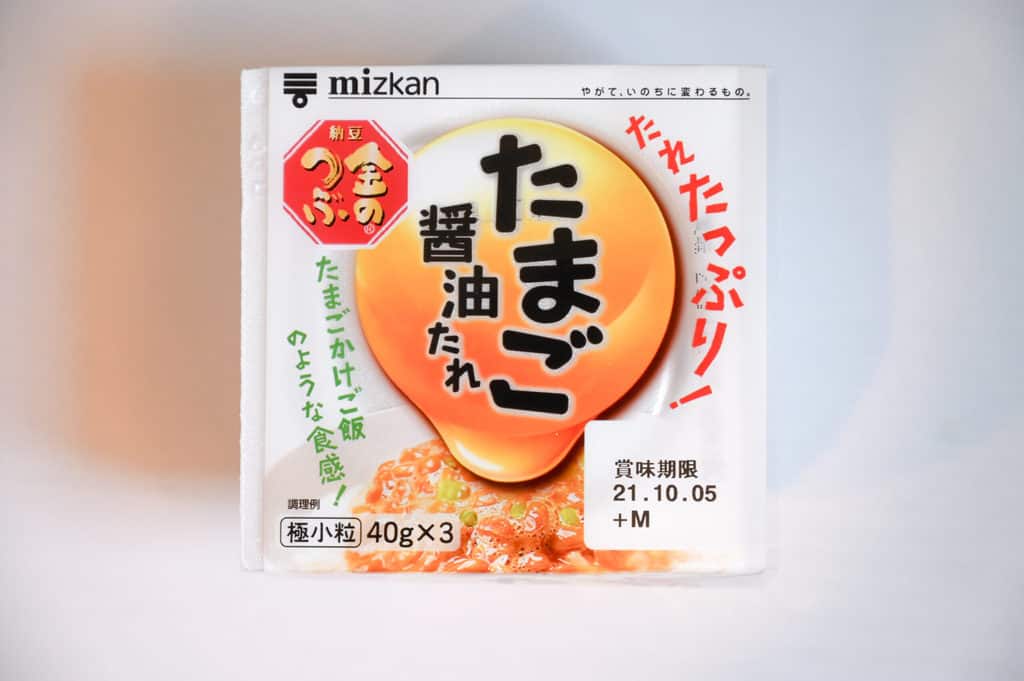
A lot of people in Japan eat natto with raw egg.
The concept of this natto is, “Why not include an egg element in one?”. I was a bit skeptical at first whether it really does taste like tamago natto, but I was wrong.
The texture and taste are well recreated, and it works beautifully.
26 Natto Topping Ideas: 20+ Years of Research Revealed
I think the beauty of natto is that you can add many different toppings and change the flavor as you like!
I’ve eaten natto for more than 20 years and have tried countless variations of toppings. So, I thought sharing my 20+ years’ worth of top list would be interesting! I can guarantee that this is the most informative natto-topping list (even including Japanese websites)!
Tenkasu (Tempura Bits)
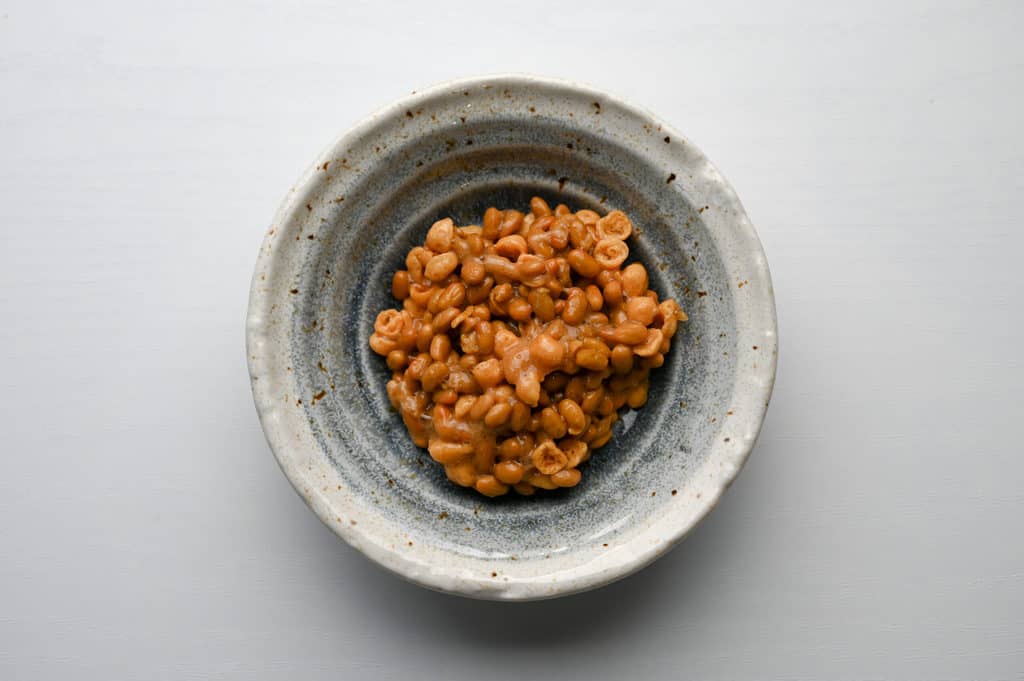
Want to add crunchy texture and a snacky sensation? Tenkasu (tempura bits) is definitely the one to consider! This topping is something I’ve loved since I was a kid.
- When to add: Mix in
- Amount: 1 tbsp tenkasu
- Recommended: Someone who wants to add a crunchy texture
- Effect: Making natto more like a snack
- My personal rating: ★★★★★ (5/5)
Grated Daikon
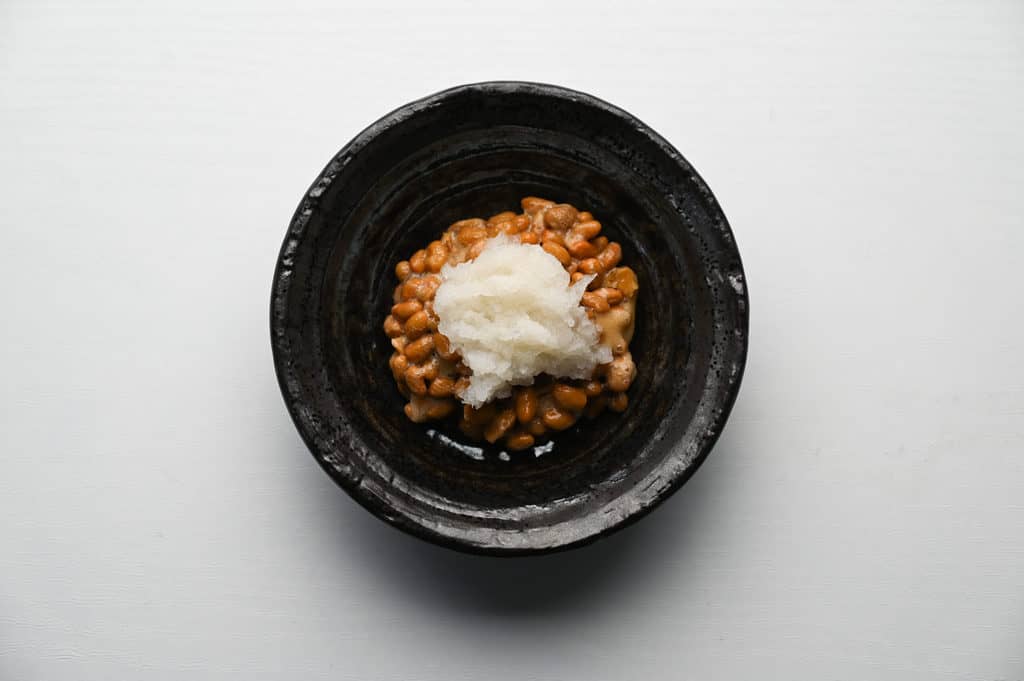
In need of a refreshing kick? Then grated daikon is a great option! It adds radish’s sourness and refreshingness in one go!
- When to add: Mix in
- Amount: 1 tbsp grated daikon radish
- Recommended: Someone who wants natto to be refreshing
- Effect: Making natto refreshing
- My personal rating: ★★★★★ (5/5)
Takuan pickles
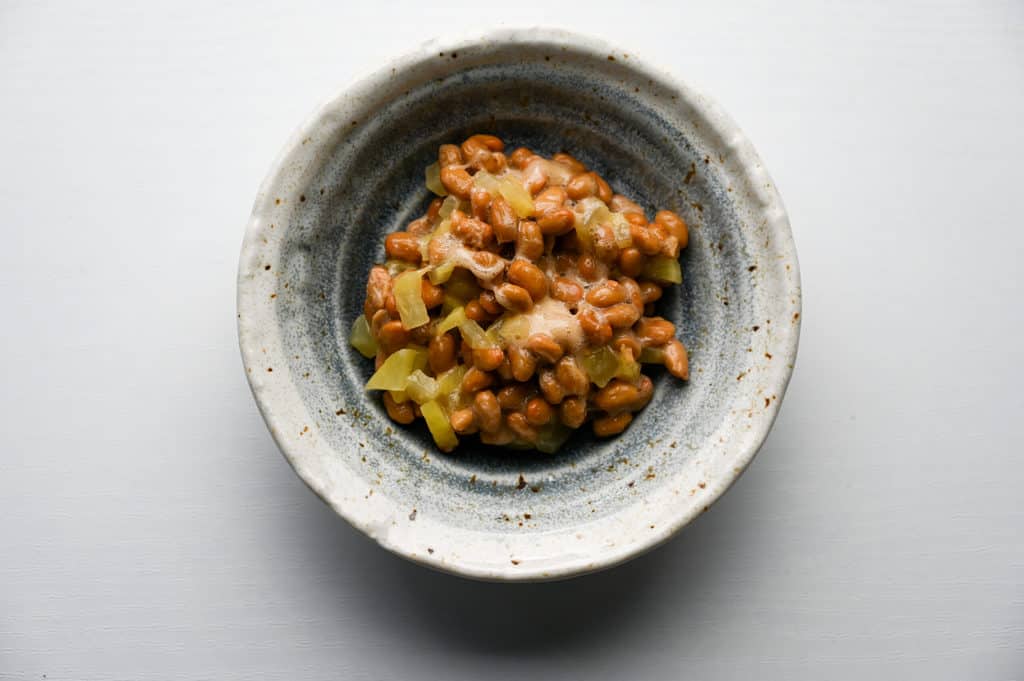
Takuan (たくあん) is a type of yellow pickled daikon. Adding sweet and sour takuan pickles is a great idea for natto! Not only is the flavor, but it also adds the crunchy texture of takuan to natto!
- When to add: Mix in
- Amount: 1-2 tbsp takuan pickles cut up small
- Recommended: Someone who likes takuan
- Effect: Create sweet and sour taste, and crunchy texture
- My personal rating: ★★★★★ (5/5)
Chilli oil
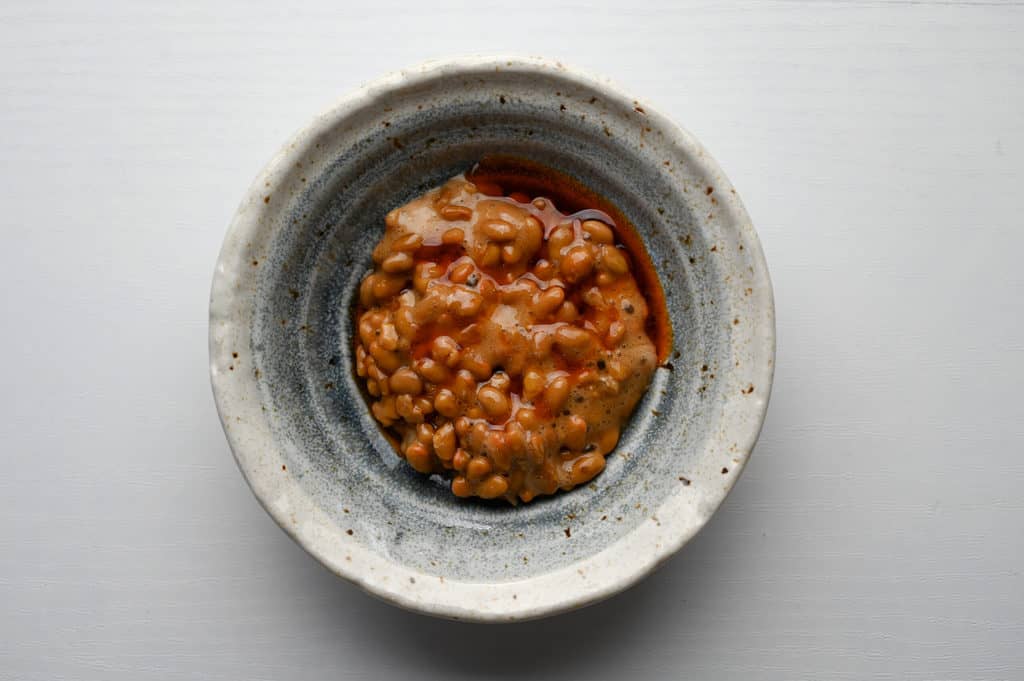
This is a classic, at least to me!
The combo of chili oil and natto is one of the best! I would add some chili oil in natto even when I was a kid. It adds a nice spicy kick.
- When to add: Mix in
- Amount: 1/2 tsp chilli oil
- Recommended: Someone who wants to add spiciness
- Effect: Making natto spicy
- My personal rating: ★★★★★ (5/5)
Avocado
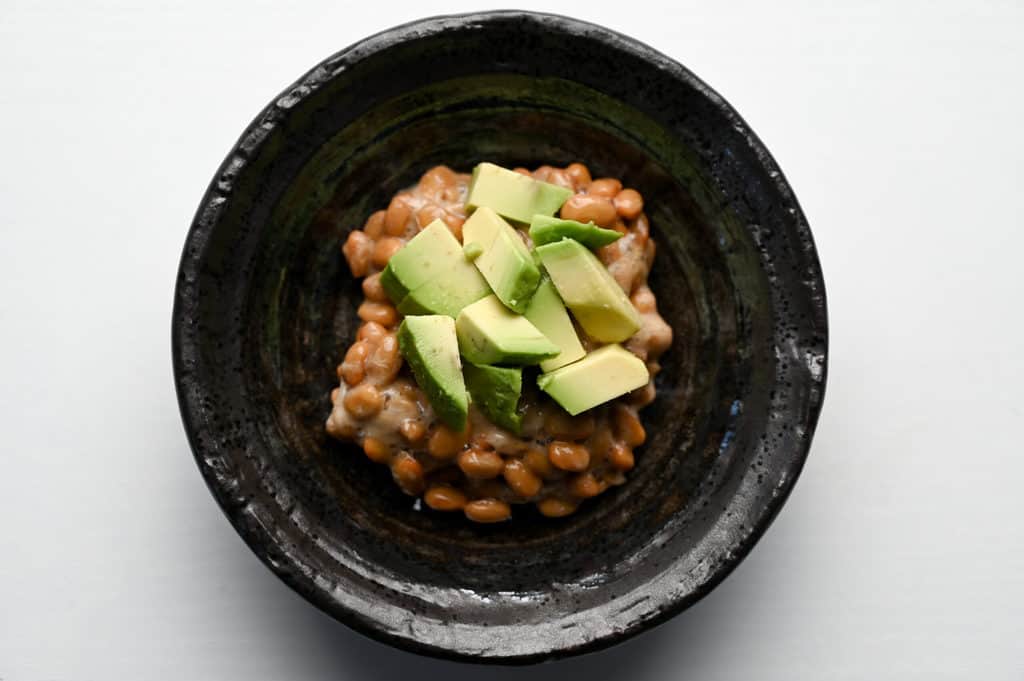
It’s a surprisingly good combo! The taste of avocado and natto goes well, and avocado creates a bit of a meaty texture!
This is one of my favorite toppings!
- When to add: At the very end
- Amount: 1/4 cubed avocado
- Recommended: Someone who likes avocado
- Effect: Creating a meaty texture
- My personal rating: ★★★★★ (5/5)
Kimchi
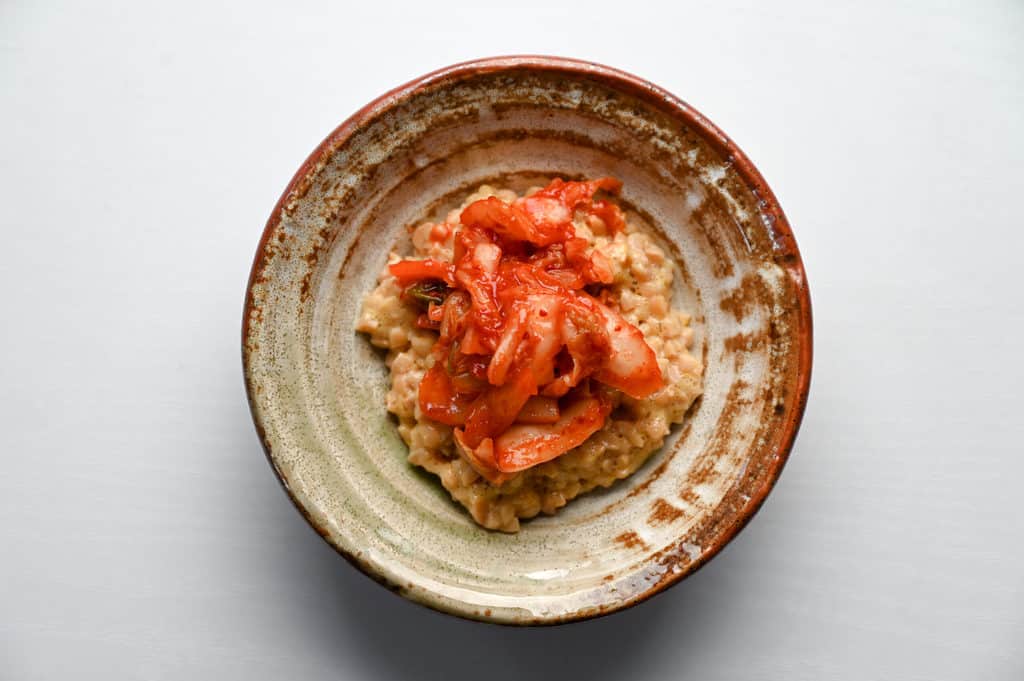
Japanese and Korean fusion! This is one of the most popular combinations, and the sourness and spiciness of kimchi actually work really well with natto!
- When to add: At the very end
- Amount: 1-2 tbsp kimchi
- Recommended: Someone who wants to add sourness and spiciness
- Effect: Adding sourness and spiciness
- My personal rating: ★★★★★ (5/5)
Sesame Oil & Salt
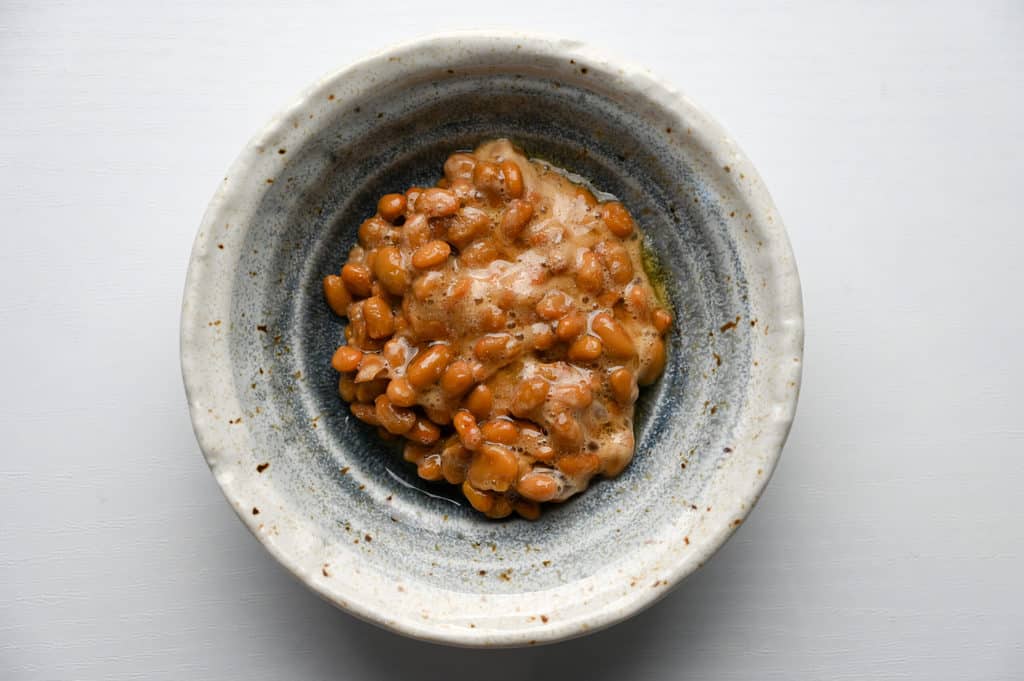
Classic golden combo, salt, and sesame oil!
You might not think they don’t make as much flavor as other toppings, but this combo will not disappoint! I recommend using a nice quality salt on this one!
- When to add: At the very end
- Amount: 1tsp sesame oil and a pinch of salt
- Recommended: Someone who likes the flavor of sesame oil
- Effect: Adding a special kick
- My personal rating: ★★★★☆ (4/5)
Finely Chopped Green Onion
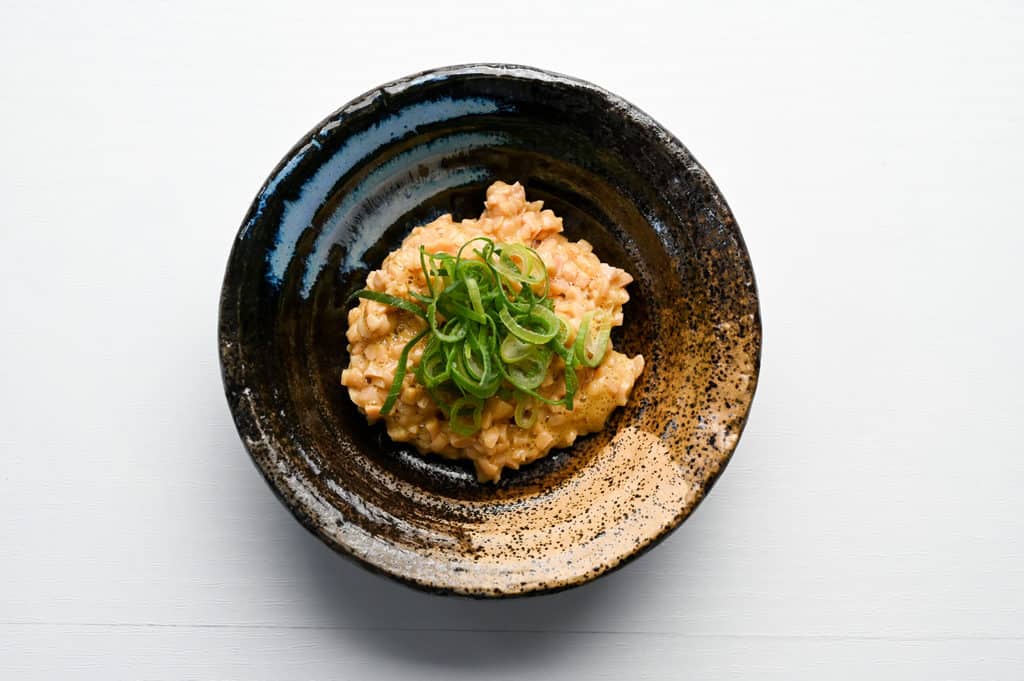
This is probably the easiest and most common topping. But it’s important to note that we only use the green part of the spring onion for the topping in this case.
Finely chop the green bit of spring onion and add it to your natto!
- When to add: Together with sauces
- Amount: 1 tbsp per pack
- Recommended: Someone who wants a refreshing taste in natto
- Effect: Natto becomes refreshing, and they’re a great combo for nutrition as well
- My personal rating: ★★★★☆ (4/5)
Chips/Crisps
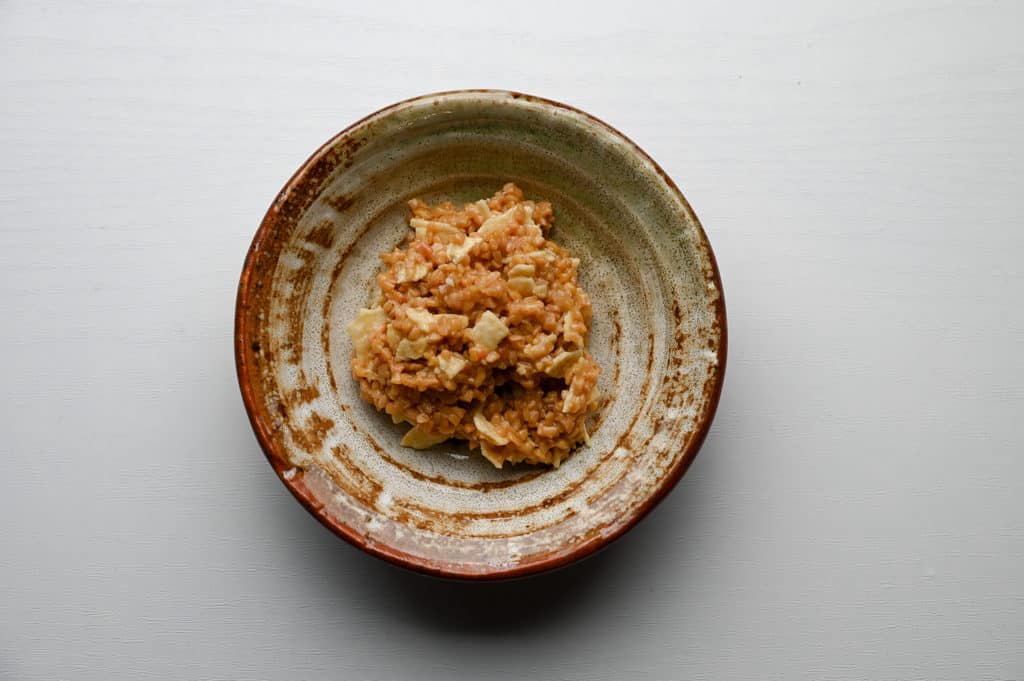
I don’t think many don’t like potato chips/crisps. Why not put it in natto?
If you like chips, maybe it’s worth trying! It adds a pleasant saltiness and some crispy texture, too! You could even experiment with different flavors. I kept it simple with lightly salted potato chips.
- When to add: Mix in
- Amount: 1 tbsp crushed potato chips/crisps
- Recommended: Someone who likes potato chips/crisps
- Effect: Gives natto crunchy texture
- My personal rating: ★★★★☆ (4/5)
Raw Egg/Egg Yolk
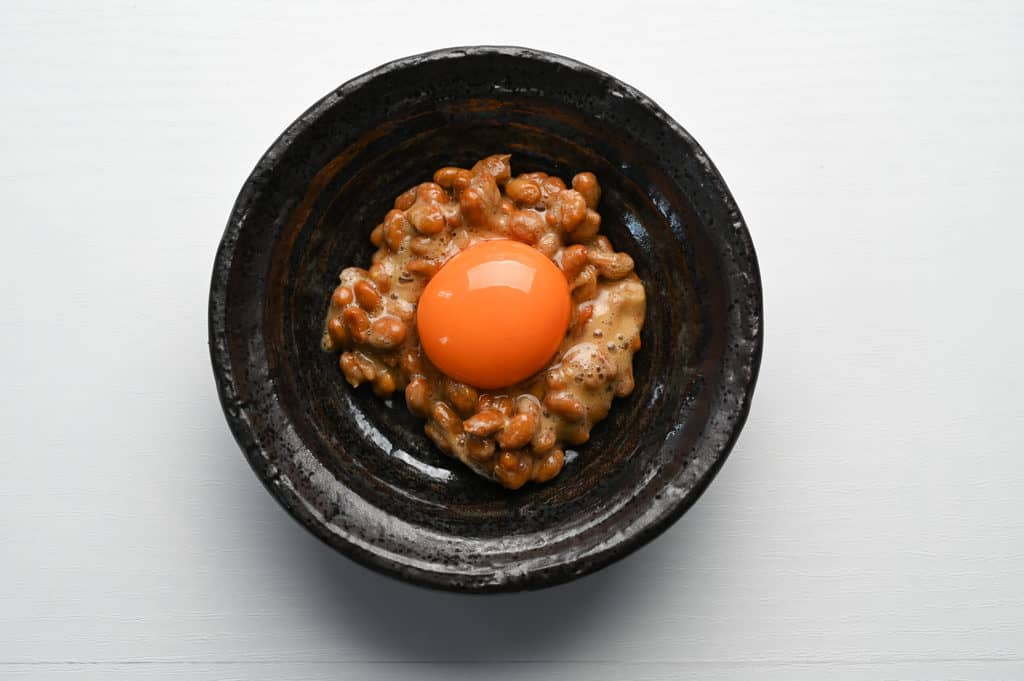
Another classic topping! It’s no secret that raw egg and natto go well together! We sometimes mix a hot bowl of rice, natto, and raw egg and call it “natto tamago gohan.” I used to love it when I was a kid.
But please make sure to use fresh and pasteurized eggs to ensure they’re safe to eat raw.
- When to add: After the sauces
- Amount: 1 egg/egg yolk per pack with extra soy sauce (about 1/2 to 1 tsp)
- Recommended: Someone who likes tamago kake gohan
- Effect: The smell of natto becomes milder, and the texture becomes more silky
- My personal rating: ★★★★☆ (4/5)
Umeboshi (Pickled Plum)
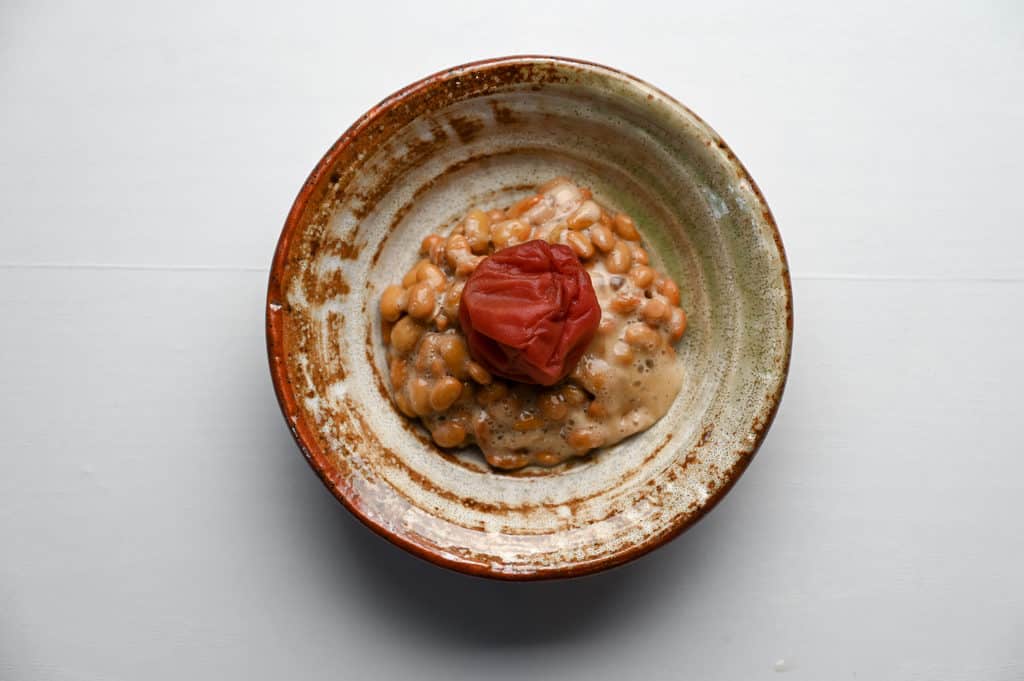
This was my favorite when I was a kid! Umeboshi (pickled plum) gives it a great sourness and texture, they work very nicely with the natto!
- When to add: At the end
- Amount: 1 umeboshi
- Recommended: Someone who likes a sour taste
- Effect: Gives a great amount of sourness
- My personal rating: ★★★★☆ (4/5)
Kizami Nori
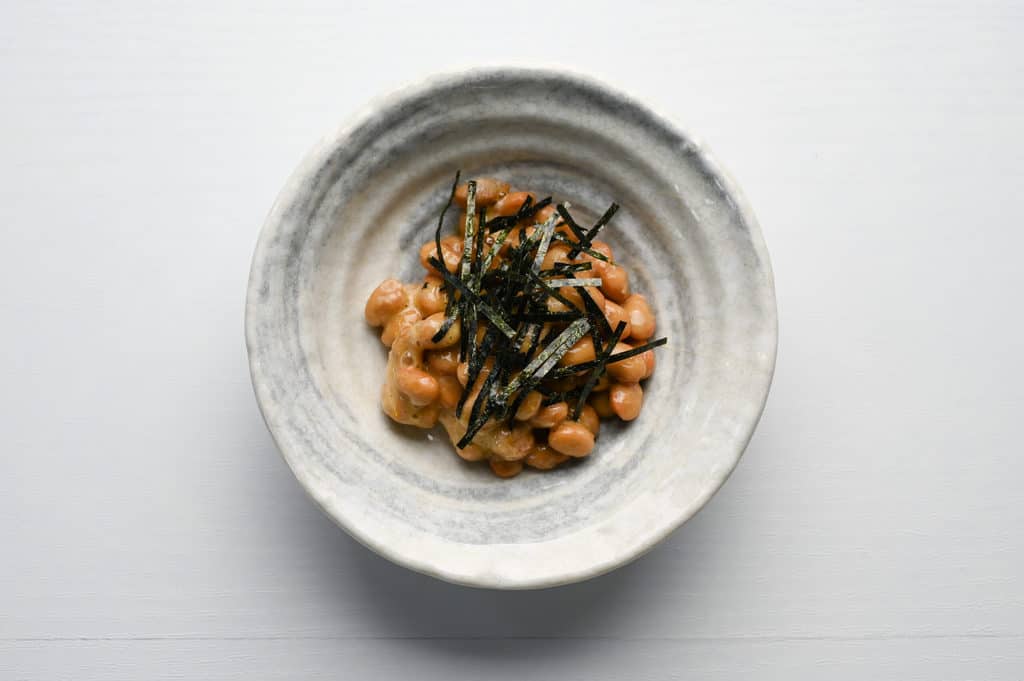
This is also a classic! The sea flavor from the nori comes together with the natto, creating a unique yet harmonious taste. You can probably tell they work well as natto sushi rolls are popular, and you can find them easily in convenience stores nationwide.
- When to add: At the very end
- Amount: 1 pinch of kizaminori per pack
- Recommended: Someone who likes nori
- Effect: Create another layer of flavor and texture
- My personal rating: ★★★★☆ (4/5)
Wasabi
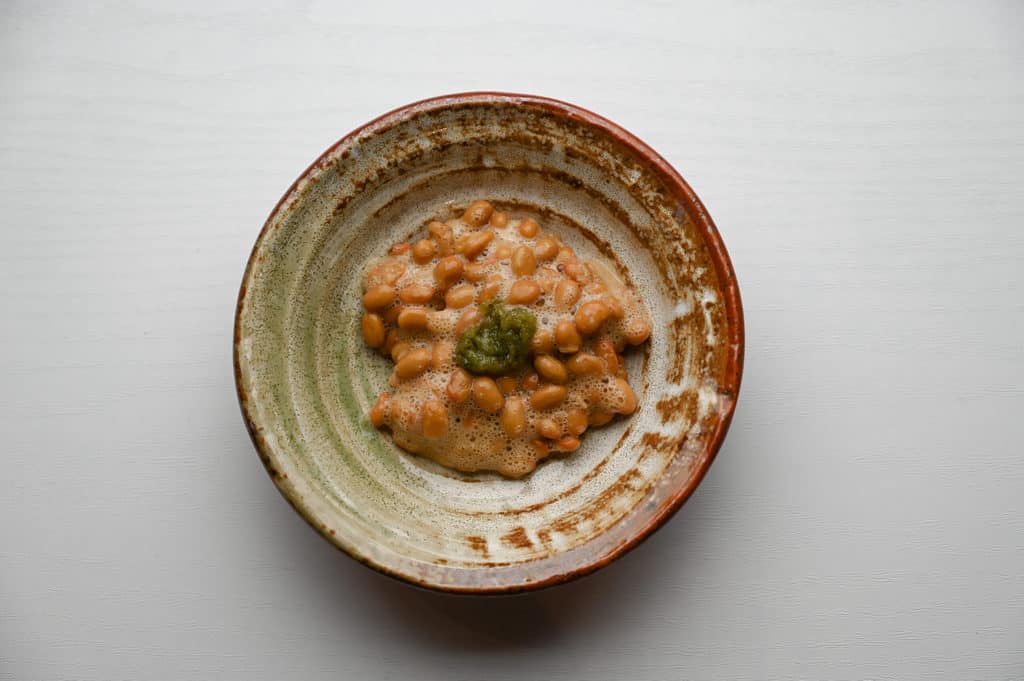
Mustard not enough? Are you a wasabi lover? Then you can add wasabi instead of mustard for a stronger kick!
- When to add: Mix in
- Amount: 1/2 tsp
- Recommended: Someone who likes wasabi
- Effect: Create a hint of wasabi
- My personal rating: ★★★★☆ (4/5)
Tabasco (Chilli sauce)
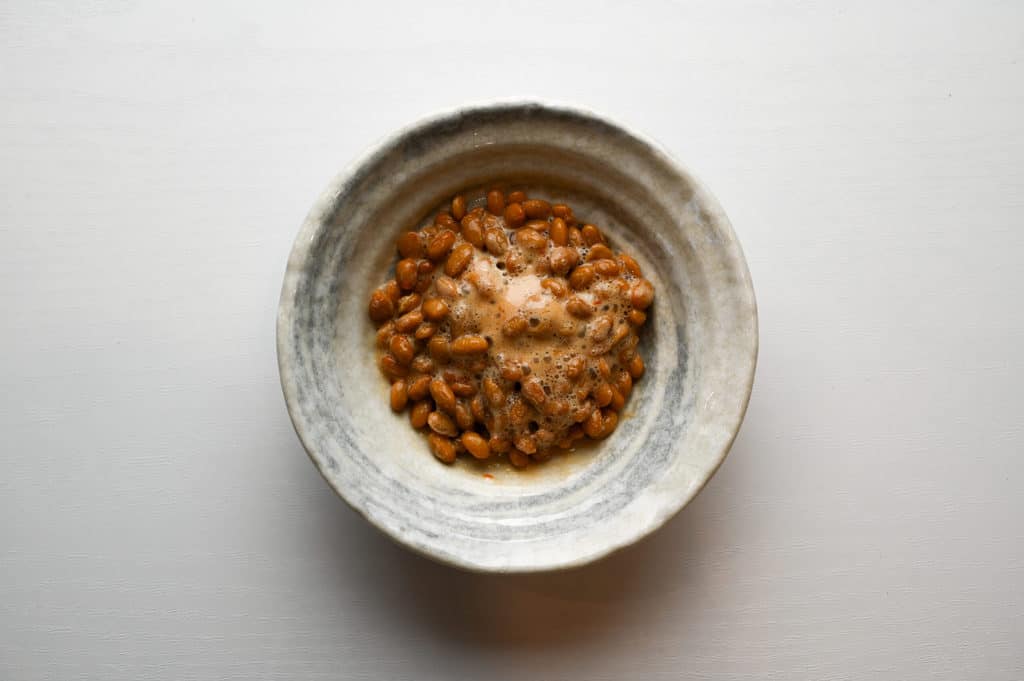
I was a bit skeptical about adding such a spicy and sour component to natto at first. However, as long as you keep the amount small, it adds a good different flavor to it.
If you like chili sauce, it’s worth a try!
- When to add: Mix in
- Amount: Dash
- Recommended: Someone who likes spicy and sour chili sauce flavor
- Effect: Create a small yet completely different flavor
- My personal rating: ★★★★☆ (4/5)
Shirasu (Boiled Whitebait)
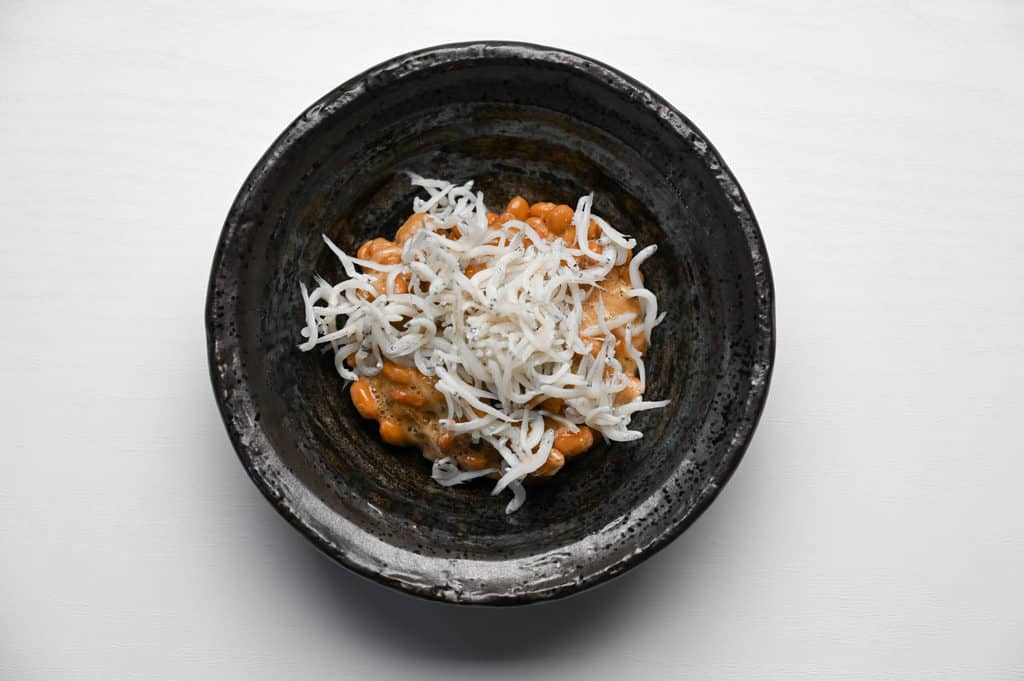
Boiled whitebait is a popular topping for many things, including natto! It gives natto a bit of fishiness and a different texture.
- When to add: At the very end
- Amount: 1-2 tbsp
- Recommended: Someone who likes shirasu or fish
- Effect: Creates a fishy taste
- My personal rating: ★★★☆☆ (3/5)
Mayonnaise & Black Pepper
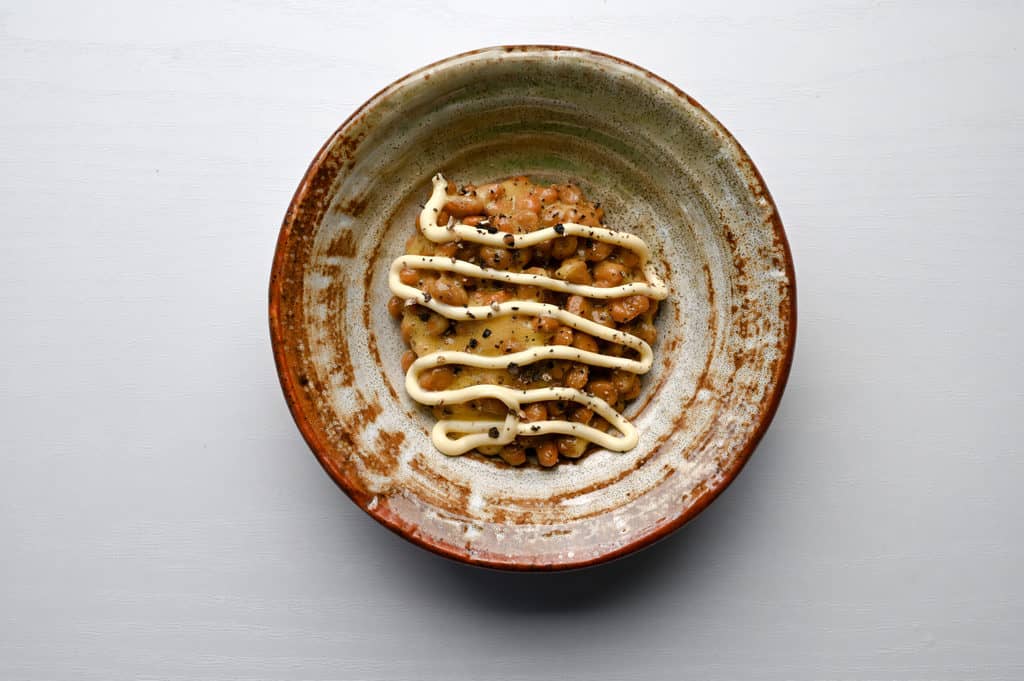
Certainly not traditional, but it’s worth a try if you like mayo and pepper or you’re not quite used to the taste of natto yet and want a strong flavor to mask it a little. Some people even say this way was a game changer and started to like natto since using these toppings.
- When to add: At the very end
- Amount: 1 pinch of black pepper and 1 tsp mayo
- Recommended: Natto beginner
- Effect: Making natto mild
- My personal rating: ★★★☆☆ (3/5)
Okura
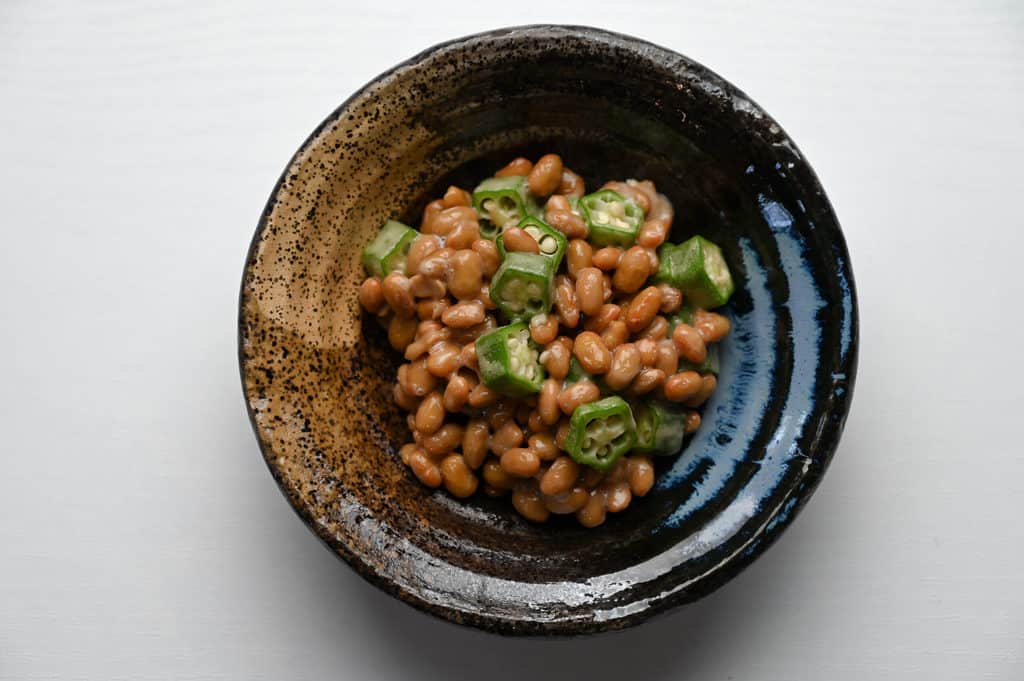
Stringy + Stringy =…?
We call stringy food “nebaneba (ネバネバ),” and this is certainly the case for nebaneba combination! Okura doesn’t alter the taste a lot, but it gives some nice color and extra nutrition to it!
- When to add: Mix together
- Amount: 3 okras
- Recommended: Someone who wants to add some vegetable
- Effect: Gives it a bit of a veggie taste
- My personal rating: ★★★☆☆ (3/5)
Ooba/Shiso Leaves
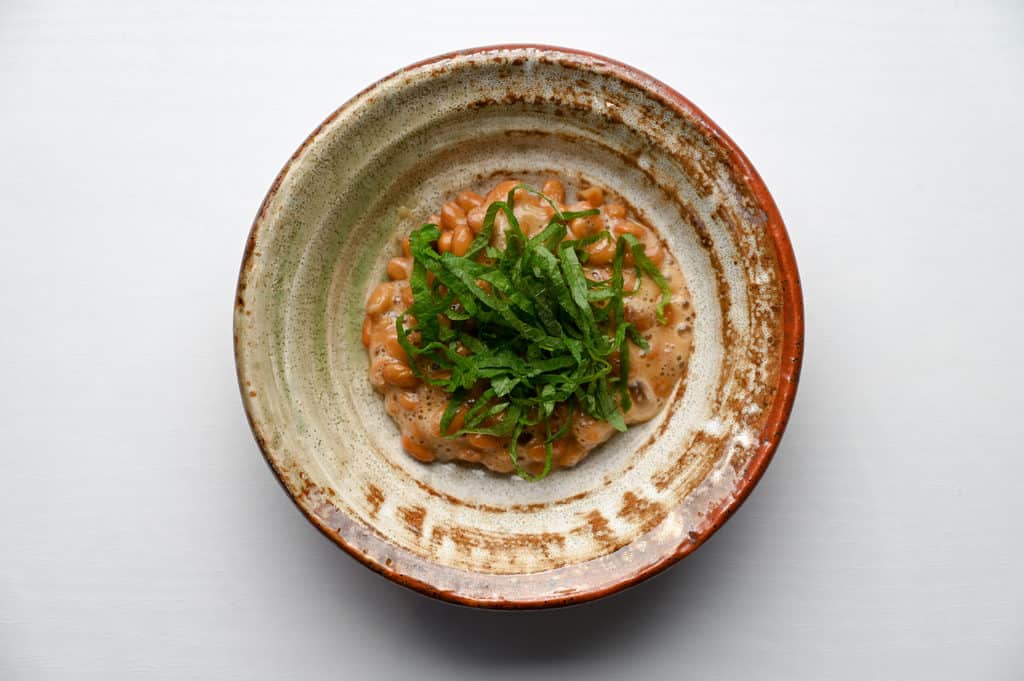
Do you like the unique flavor of shiso/ooba leaves? If so, this might be your go-to topping! It’s subtle but gives it shiso leaf flavour!
- When to add: Mix together
- Amount: 2 shiso/ooba leaves
- Recommended: Someone who likes shiso/ooba leaves
- Effect: Adds the unique flavor and texture
- My personal rating: ★★★☆☆ (3/5)
Pesto & Olive Oil
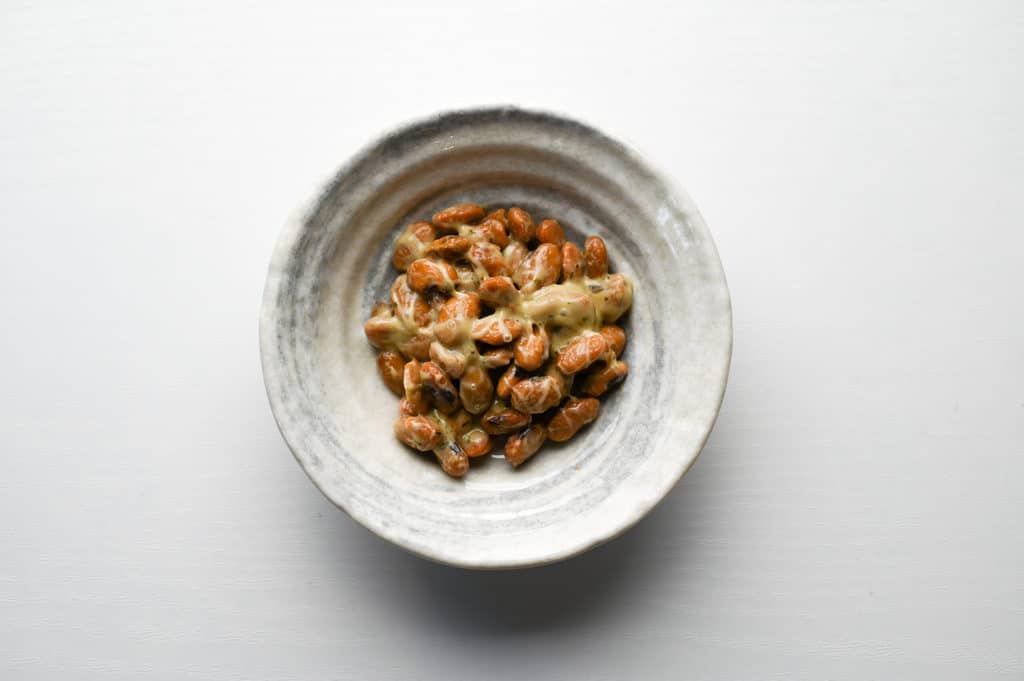
It’s a slightly quirky combo with pesto and olive oil.
While you can have a completely different experience with natto, the chemistry is questionable. But don’t get me wrong, I’ve always loved pesto and olive oil!
- When to add: Use instead of soy sauce and mustard
- Amount: 1/2 – 1 tbsp pesto and a dash of olive oil
- Recommended: Someone who wants to try something completely different
- Effect: Create a completely different sensation
- My personal rating: ★★★☆☆ (3/5)
Hard Cheese & Black Pepper
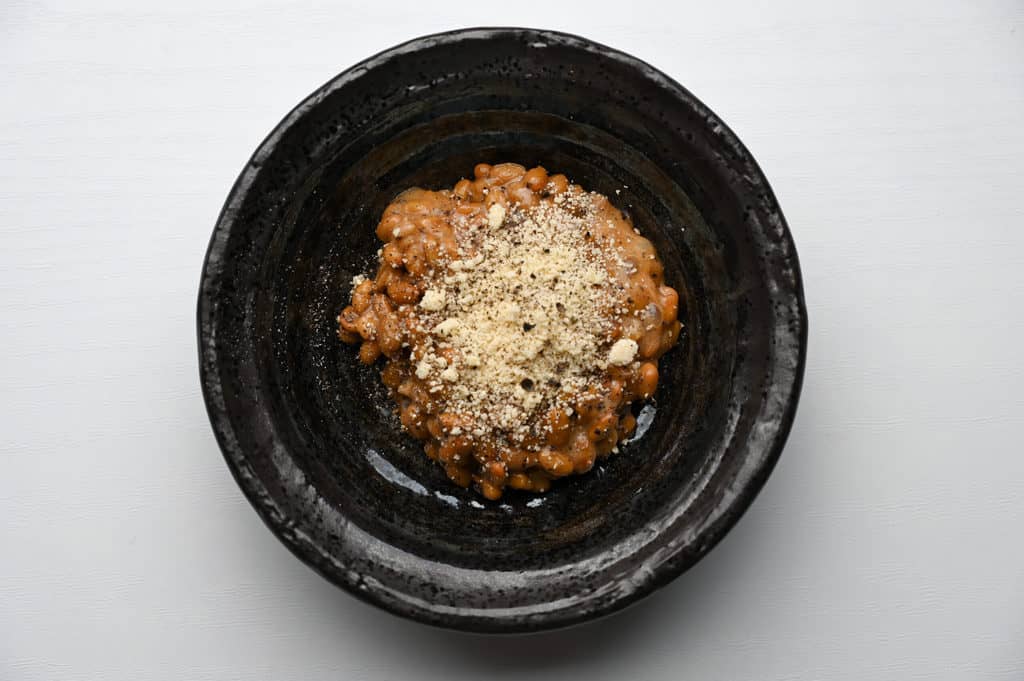
Natto and cheese might not be the first idea to come up, but some people like this combo! The effect is quite subtle, giving a bit of a cheesy hint to natto.
- When to add: Mix together
- Amount: 1 tsp grated Parmigiano
- Recommended: Someone who likes the cheesy flavor
- Effect: Adds a hint of cheesiness
- My personal rating: ★★★☆☆ (3/5)
Mentaiko (Spicy Cod Roe)
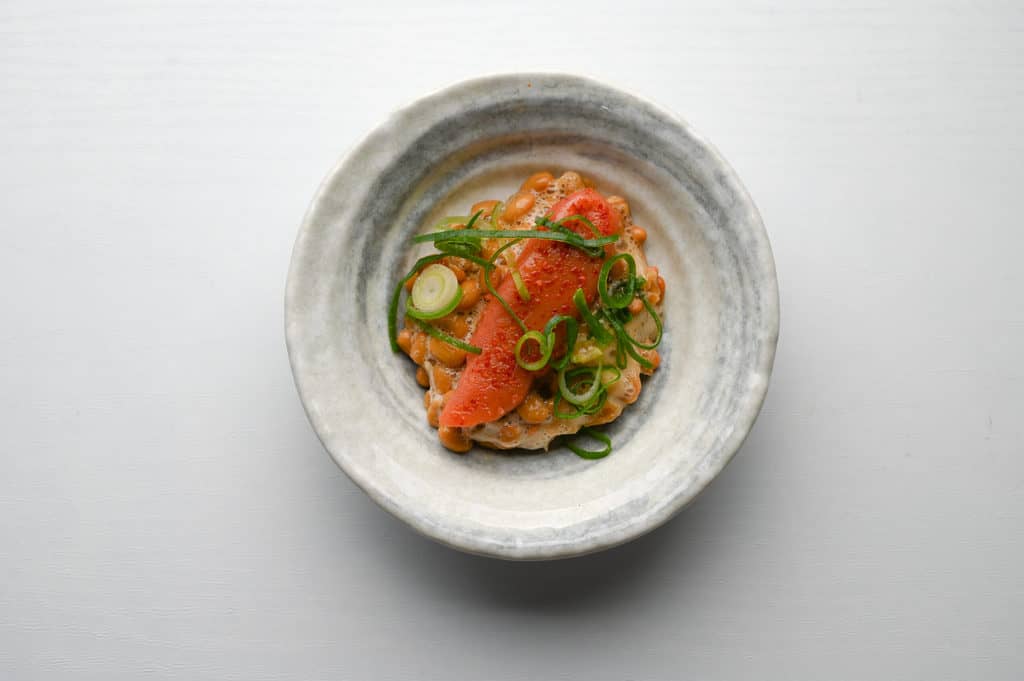
Mentaiko is an ingredient made with pickled Alaskan pollock eggs that have been flavored with chilis and spices. It certainly gives a different texture and taste to natto, but it’s not as powerful as I thought it would be.
If I use mentaiko, I’d prefer to use it for mentaiko pasta.
- When to add: Mix together
- Amount: 1 small mentaiko
- Recommended: Someone who likes mentaiko and its texture
- Effect: Adds a uniquely different flavor and texture
- My personal rating: ★★★☆☆ (3/5)
Honey
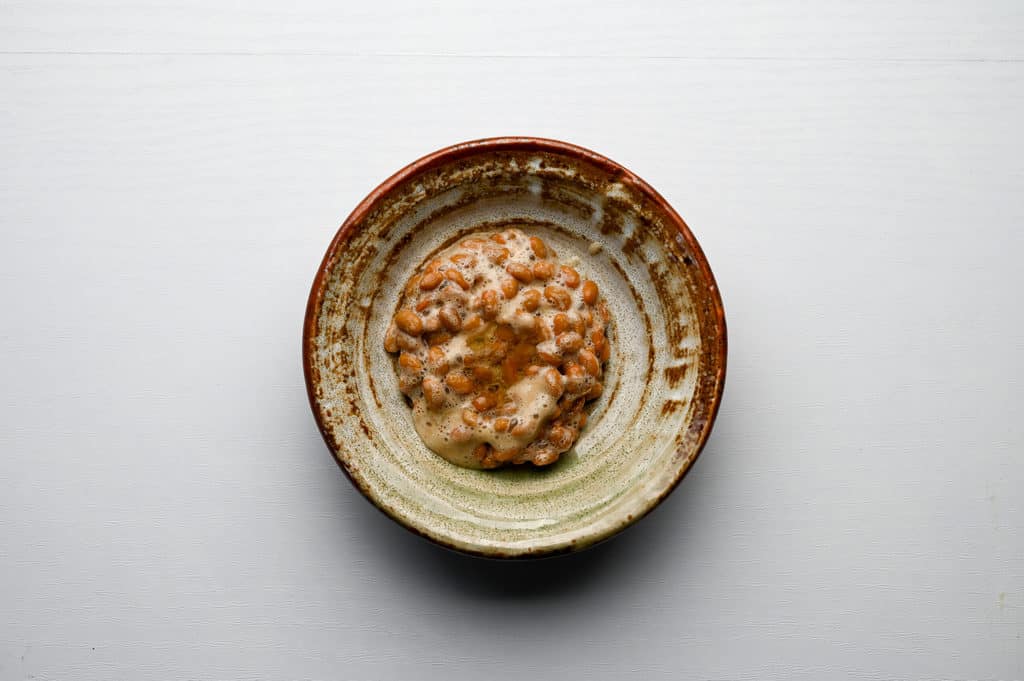
Extremely surprising topping, but some people in Japan put a bit of honey to make it sweeter.
It’s definitely something that you don’t want to do it over! While the added sweetness is not overpowering, it won’t be my go-to topping as I prefer savory foods. But if you like some sweetness in your foods, it’s worth trying!
- When to add: Mix together
- Amount: 1/4 tsp
- Recommended: Someone who wants to sweeten natto
- Effect: Adds a unique sweetness
- My personal rating: ★★★☆☆ (3/5)
Katsuobushi (Bonito Flakes)
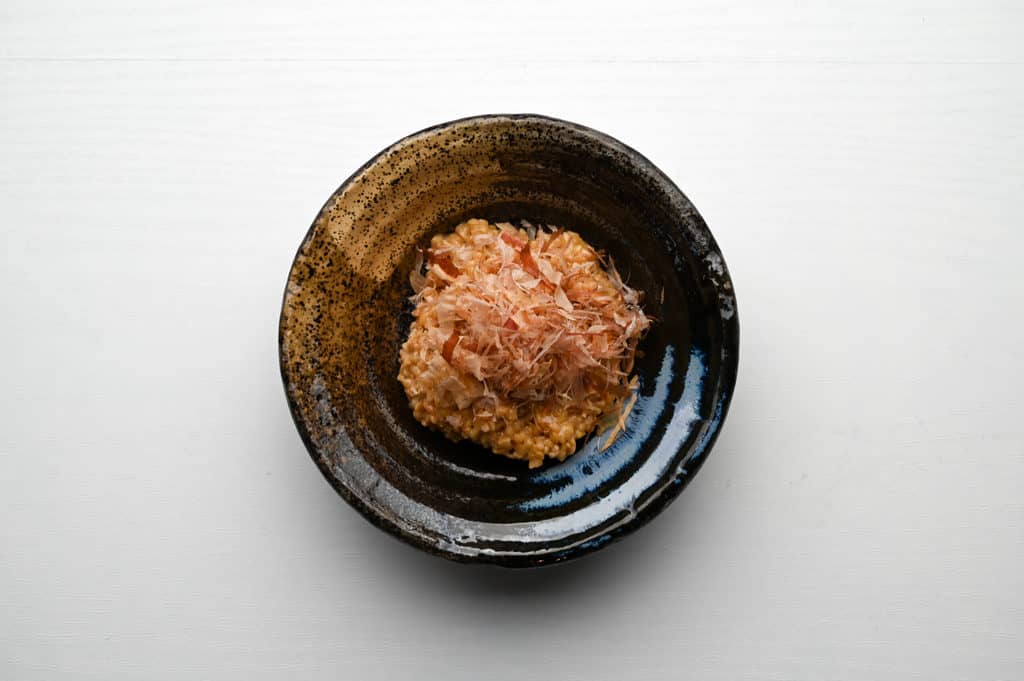
Katsuobushi is the name for bonito flakes made with dry flakes of skipjack tuna. It’s a must-have item for Japanese cuisine! While it hints at a fishy taste, the effect is still subtle.
- When to add: Mix together
- Amount: 1 tsp katsuobushi
- Recommended: Someone who likes fishy flavor
- Effect: Adds a hint of fishiness
- My personal rating: ★★★☆☆ (3/5)
Curry Powder
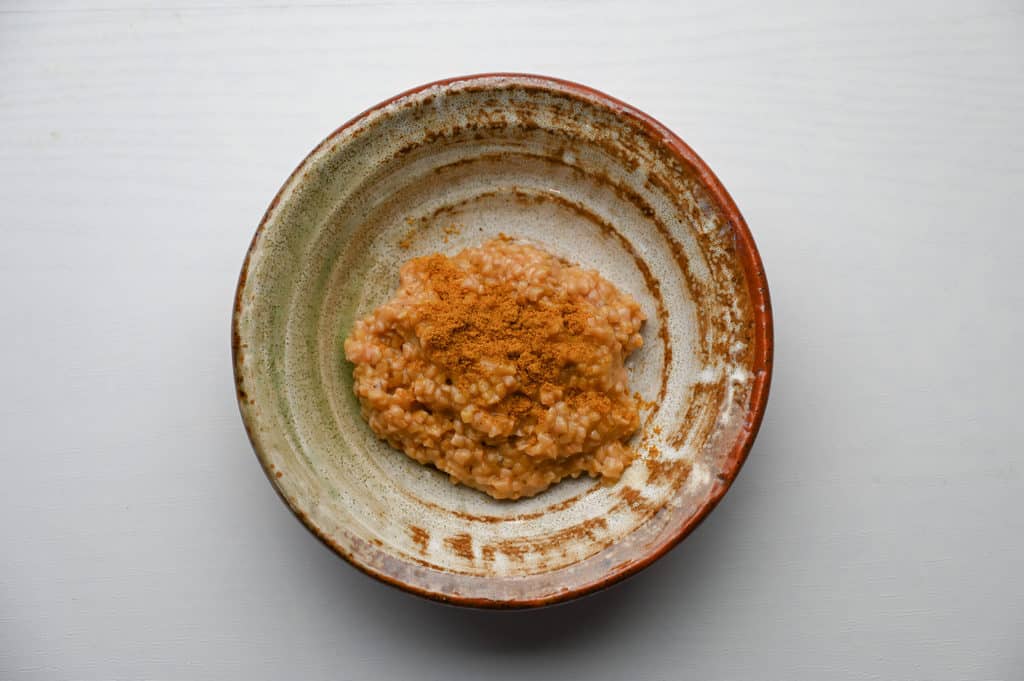
Do you like a slight curry flavor? Adding a tiny bit of curry powder gives natto a completely different twist.
- When to add: Mix in
- Amount: 1/8 tsp curry powder
- Recommended: Someone who likes curry flavor
- Effect: Adds a hint of curry
- My personal rating: ★★★☆☆ (3/5)
Ponzu
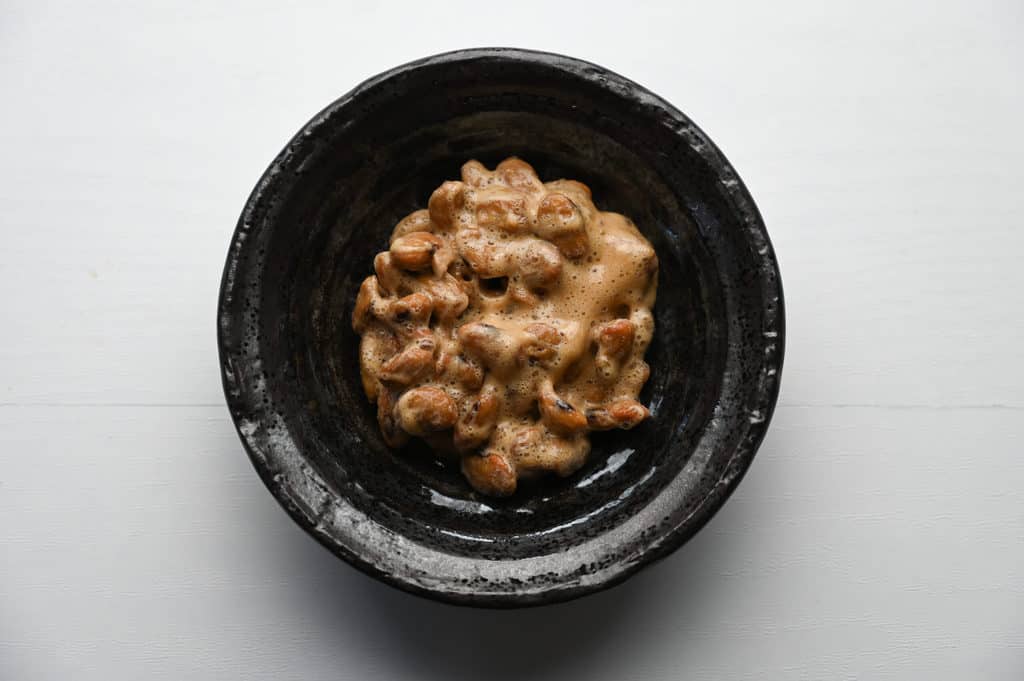
Ponzu is a vinegary, sour Japanese condiment that goes well with many things like cold tofu.
While it gives natto a particular sourness, it was slightly disappointing for me. I love sour flavors, so maybe it wasn’t sour enough; if you like a mildly sour flavor, you may try this.
However, if you are like me and want to add real sourness, I recommend pickled plums instead.
- When to add: Use ponzu instead of soy sauce
- Amount: 1 tsp
- Recommended: Someone who likes the mildly sour flavor
- Effect: Adds the particular ponzu sourness
- My personal rating: ★★☆☆☆ (2/5)
Miso
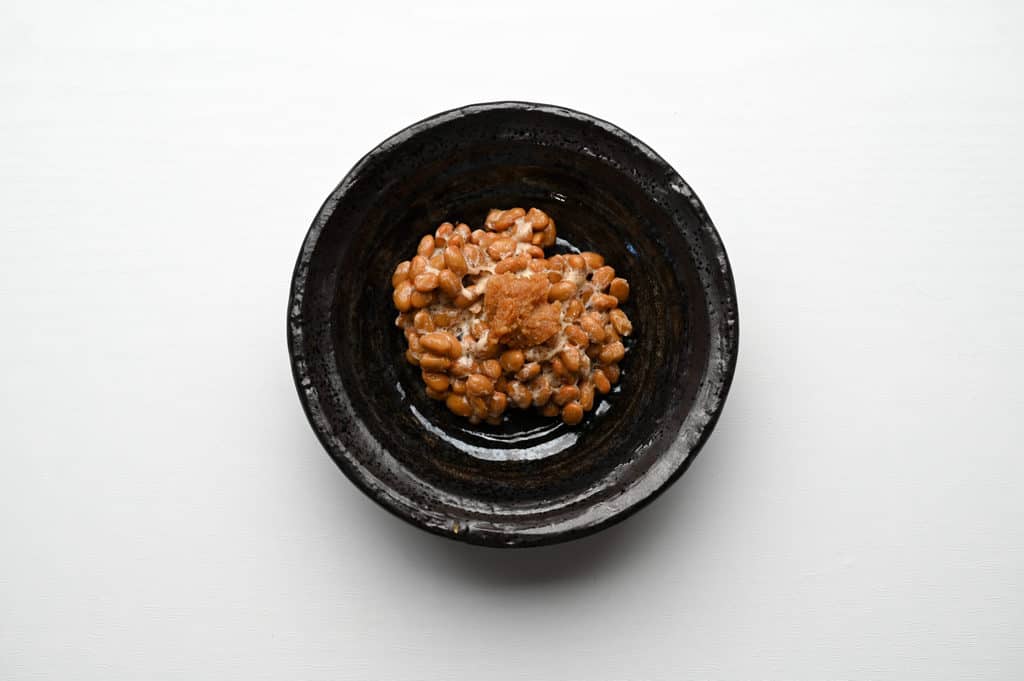
When I tried to replace soy sauce/tsuyu with miso, there was one concern: Is it going to be too salty?
It wasn’t as salty as I expected; however, the texture of the natto became a bit dry and wasn’t as good without a liquid form of condiment.
So, I don’t particularly recommend this.
- When to add: Use miso instead of sauce
- Amount: 1/2 tsp
- Recommended: Not really recommend
- Effect: Adds miso flavor
- My personal rating: ★★☆☆☆ (2/5)
Verdict: 3 toppings that I particularly recommend
In conclusion, there have been amazing toppings and not-so-great toppings. To sum up, the 3 best toppings for natto are:
- Tenkasu (Tempura bits/flakes): 1 tbsp
- Chilli oil: 1/2 tsp
- Grated daikon: 1 tbsp
I hope you learned a lot about natto from this post. What’s your favorite brand or topping? Comment below!
FAQ
Even though natto is something every Japanese person knows, the history has always been uncertain.
The oldest document in which the word “natto” can be found is in the “Shin-sarugaku-ki” written by Fujiwara no Akihira in the mid-11th century.
However, soybeans were already introduced to Japan in the Jomon period (around 14,000-10,000 BC). In the Yayoi period (around 10,000 BC to 300 AD), Japanese houses were covered with straw, and there were furnaces, so the temperature and humidity were suitable for the growth of bacteria, and it is believed that this led to the accidental production of natto.
Nonetheless, natto has a long history!
Yes, natto is still a well-loved breakfast in Japan, and I eat it almost every day while I’m in Japan. Wherever you stay in Japan, there’s always natto in the hotel’s breakfast buffet.
But when did this breakfast tradition start?
Regardless of natto’s long history, it is said that it was first popularised in the Edo period (1603-1868). That’s when people start eating natto for breakfast.
This was also the period when the mass production of soy sauce began, so it kind of makes sense! I wouldn’t dare to eat natto without soy sauce myself, either!
There are different ways to make natto, but here is the general method that factories use to produce natto:
1. Wash soybeans
2. Soak in water
3. Steam
4. Apply natto bacteria
5. Storing it in a large container
6. Fermentation
7. Maturing
8. Packaging
9. Delivery
Although you can make natto at home as well, it’s extremely rare to do so, even in Japan. We just buy packs of natto at supermarkets.
I hope you enjoy this Natto article! If you try it out, I’d really appreciate it if you could spare a moment to let me know what you thought by giving a review and star rating in the comments below. It’s also helpful to share any adjustments you made to the recipe with our other readers. Thank you!
More 101 Articles
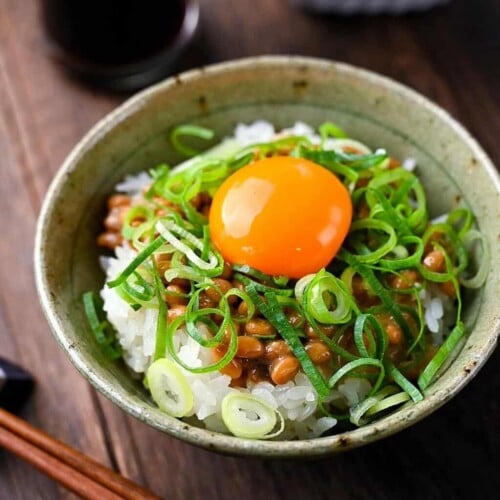
Natto Gohan (Japanese Fermented Soybeans on Rice)
Ingredients
- 1 pack natto
- 150 g cooked Japanese short-grain rice
- your choice of toppings see in post for ideas – I used 2 tbsp chopped spring onion and an egg yolk in the picture
Instructions
- Dish 150 g cooked Japanese short-grain rice up into a bowl.

- Open 1 pack natto and whisk with chopsticks at least 50 times (preferably 150) until foamy and stringy.

- Add the sauce included in the natto and mix until evenly distributed. (Usually mustard and soy sauce are included, swap for suitable alternatives if following a gluten-free diet.)

- Add your choice of toppings (see in post).

- Enjoy!
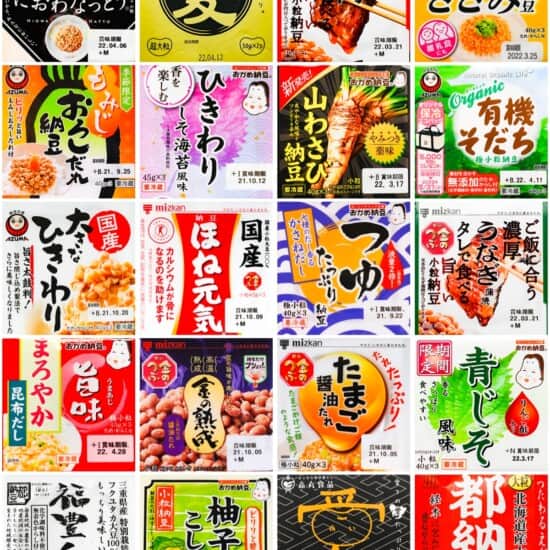


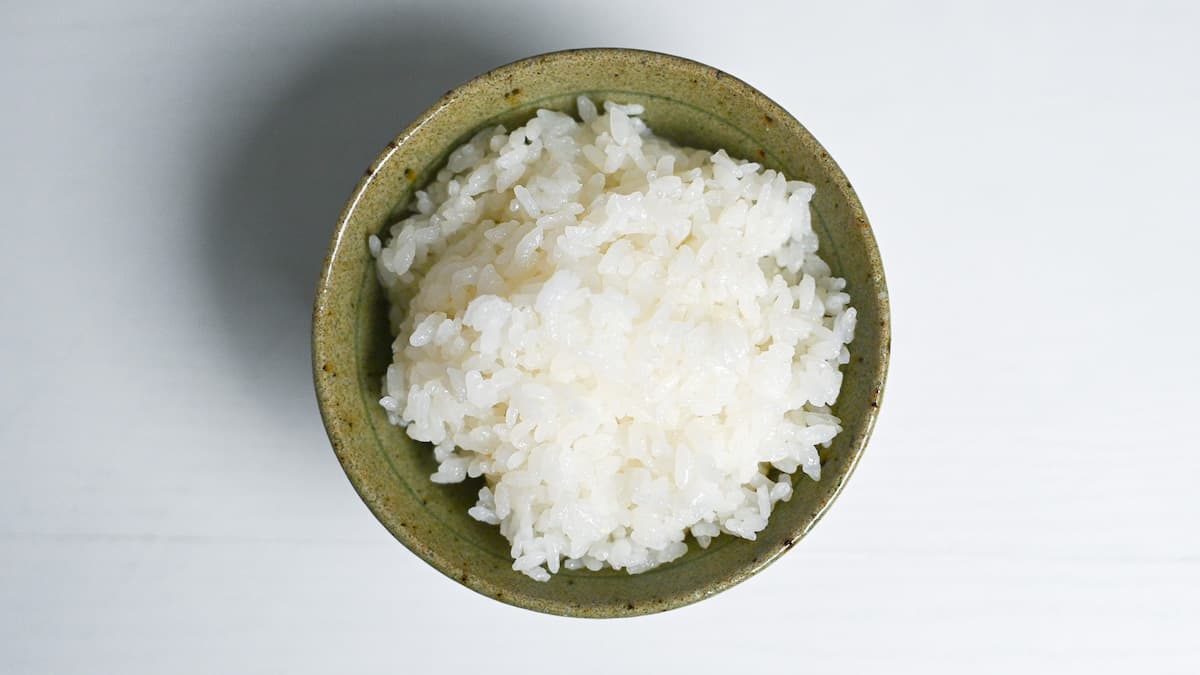
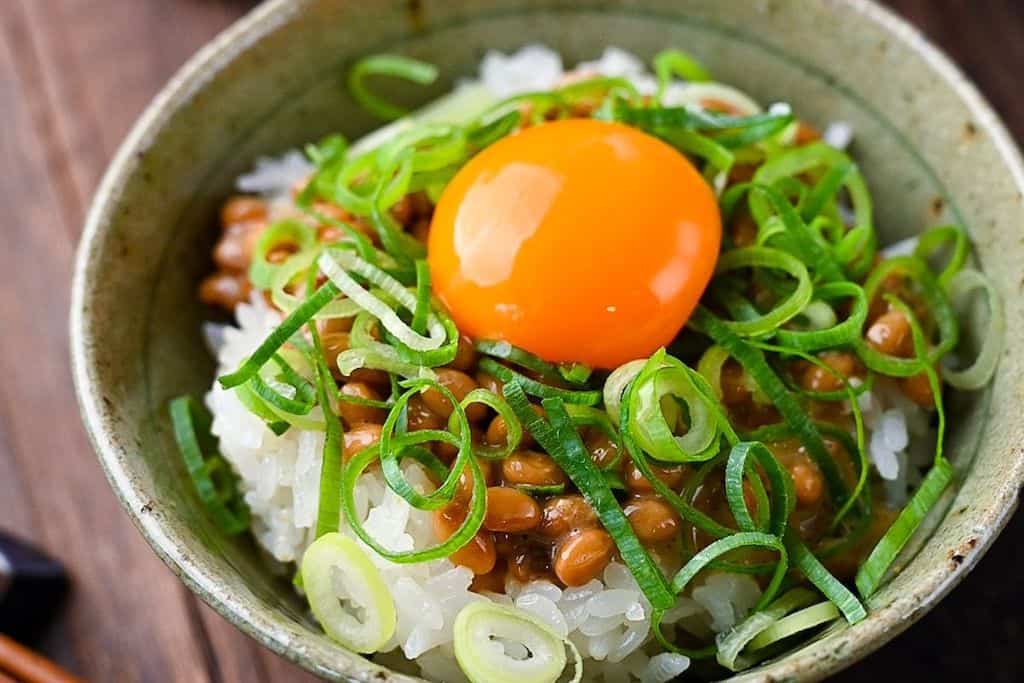
I really like these topping ideas for natto. Have you ever pan fried natto with tsuyu until little grilled? Very good that way too and it does get rid of some wonderful aroma of natto for those who are not too keen.
Thanks so much!
I’m a huge fan of natto so I’ve never thought about frying it. It sounds interesting, I’ll try it out. Thanks for your suggestion.
Would frying not kill the probiotic?
Hi Robbie,
It would, but not everyone eats natto for the probiotic qualities in Japan. People who just love the taste of natto might fry it with rice or add it to other dishes, and some people who find it too strong might like it more if it’s cooked into something else. But like you said, if you want to enjoy all the probiotic qualities natto should be eaten raw.
Thank you for your question!
Here’s an odd idea, I like Natto on crispy juicy apple slices like gala or cosmic crisp. It’s kind of the idea of cheese and apples.
What an interesting idea! I’ll have to try it. Thanks for your comment and rating 🙂
Excellent ideas, but I see some people posting about frying natto, from what I read that’s a no-no.”To maximize preservation of natto’s probiotic and other functional components like nattokinase enzymes, we generally recommend to try to avoid boiling or cooking natto extensively at high temperatures. Adding natto to hot foods at the very end of cooking or just before serving will allow it to retain its full activity”
Hi Donna,
You’re right about that, nattokinase is delicate and any heat (even the heat from cooked rice) can damage it and impact the nutritional value, so if you’re eating natto only for your health then its better to eat it on its own. However in Japan, we eat natto because we like the taste and we don’t really think so seriously about eating natto for our health, that’s why people enjoy it on cooked rice or even fry it together with rice.
Thank you for your comment!
An Italian take for those who liked the chili oil one: try adding natto to a dish of spaghetti aglio olio pepperoncino
Great idea! I’ll have to try this. Thanks for sharing!
My host mom used to mix the nato with its soy and mustard packets…then mix with tuna and stuff into an aburaage pocket and crisp up on a grill (many stoves in japan have a GLORIOUS built in broiling drawer that i wish was common here) or in a pan. This was my introduction to nato and it is simply scrumptious.
That sounds amazing, especially for first-timers who might not enjoy natto on its own! Thanks for sharing!
Thank you! This exactly explained what natto is & how to eat it. Now I need to find someplace near me that sells natto in pkgs.
Hi Georgia,
You’re welcome! I hope you can find and enjoy natto!
I like to add furikake or kombu tsukudani.
Thanks for sharing!
Very good website!
Thank you.
Thank you!